Feature
- VISIT YAMAGATA
- Feature
- [Feature] Benibana in Kahoku Town! Safflower dyeing workshop
[Feature] Benibana in Kahoku Town! Safflower dyeing workshop
- Kahoku
- 2022.06.21
Sightseeing・ Activity
Summer Recommended Photos Girls Family Children Culture
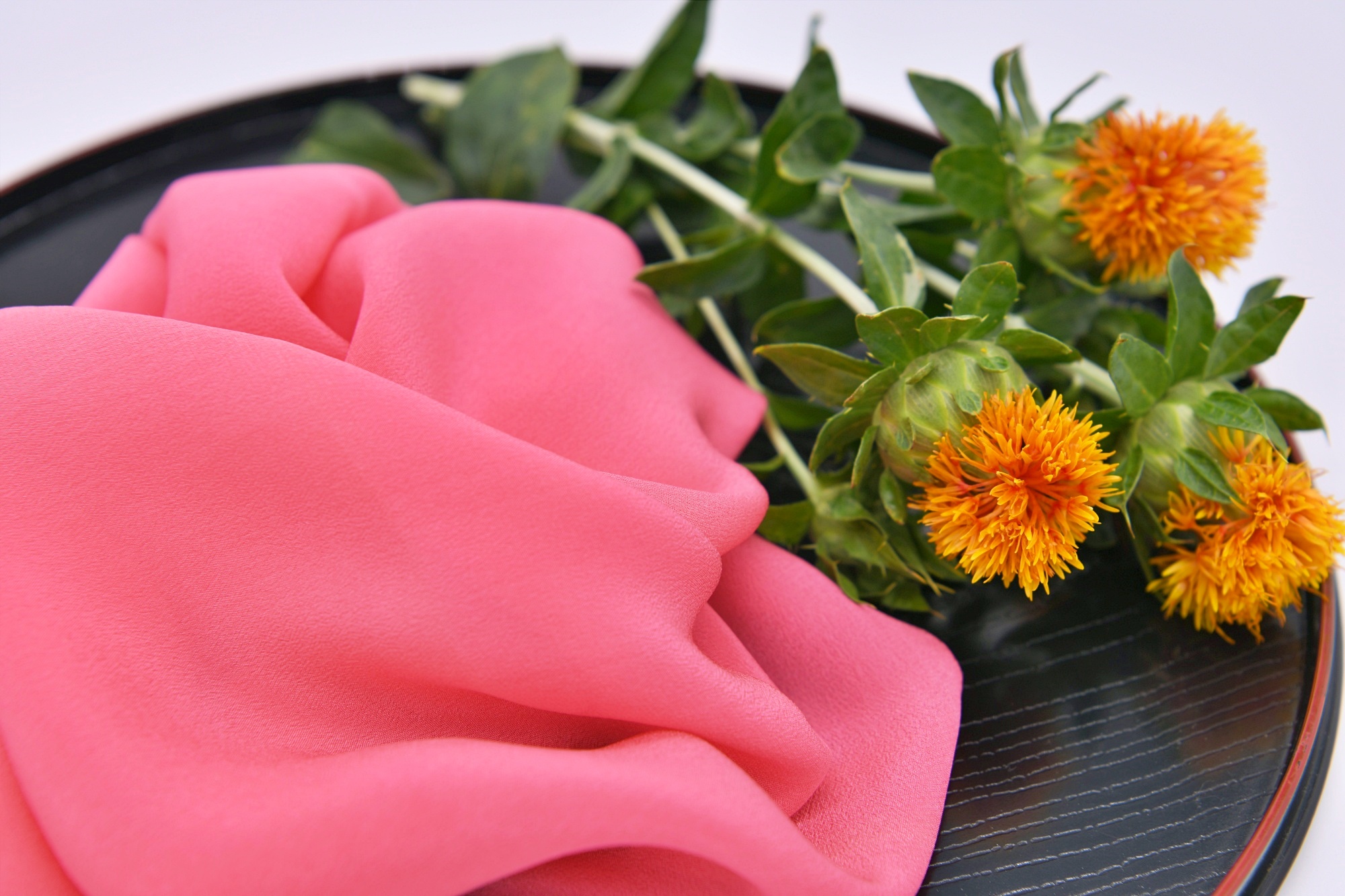
The charm of safflower dyeing lies in its beautiful colors.
The petals of safflower contain a yellow pigment (Saflower Yellow) and a red pigment (carthamin), which can be dyed from yellow to red.
The deeper the safflower, the more expensive it was because many safflowers were needed to dye it in a high-purity safflower.
Therefore, in the Edo period, only a limited number of people could wear kimono dyed in deep crimson.
I came to the Kahokucho Benibana Museum when I heard that I could easily experience this safflower dyeing.
Please take a look at the exciting experience of what kind of color it will be dyed.
1. Benibana Museum
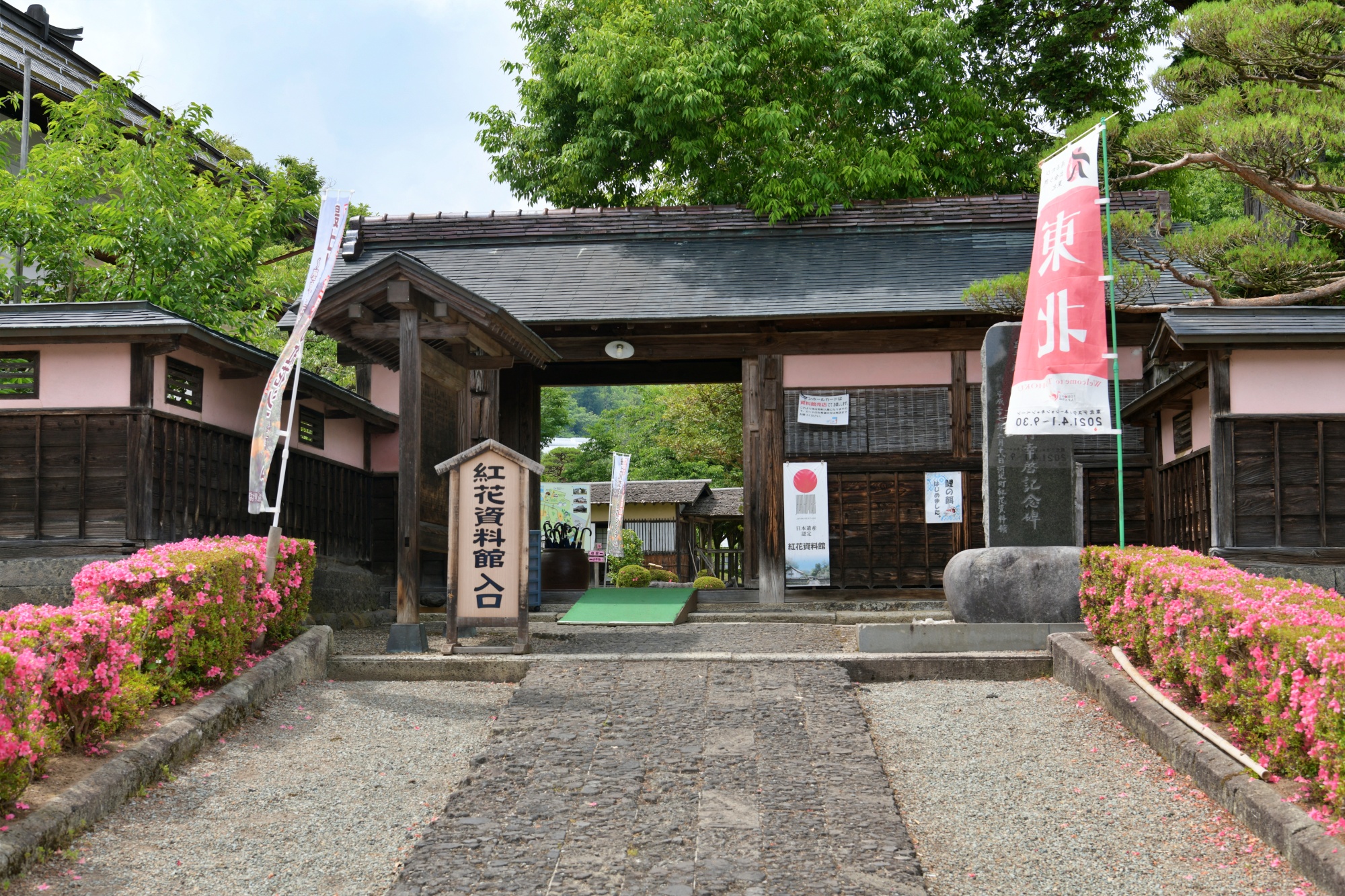
The Benibana Museum I visited this time is the site of the mansion of Yuto Horigome, who was the richest man in the neighborhood.
* Neighborhood: Nearby village
Kahoku Town, where the museum is located, once prospered as a town of * Kahoku.
* River port: A port set up on the riverbank
Rice and red flowers gathered from various parts of the Murayama region descend to Sakata on the Mogami river, pass through the Sea of Japan, land in Tsuruga (currently Tsuruga City, Fukui Prefecture), and pass through Lake Biwa and the Yodo River to Kyoto and Osaka. Was sent to.
The Horimai family has made a fortune by collecting and shipping rice and safflower.
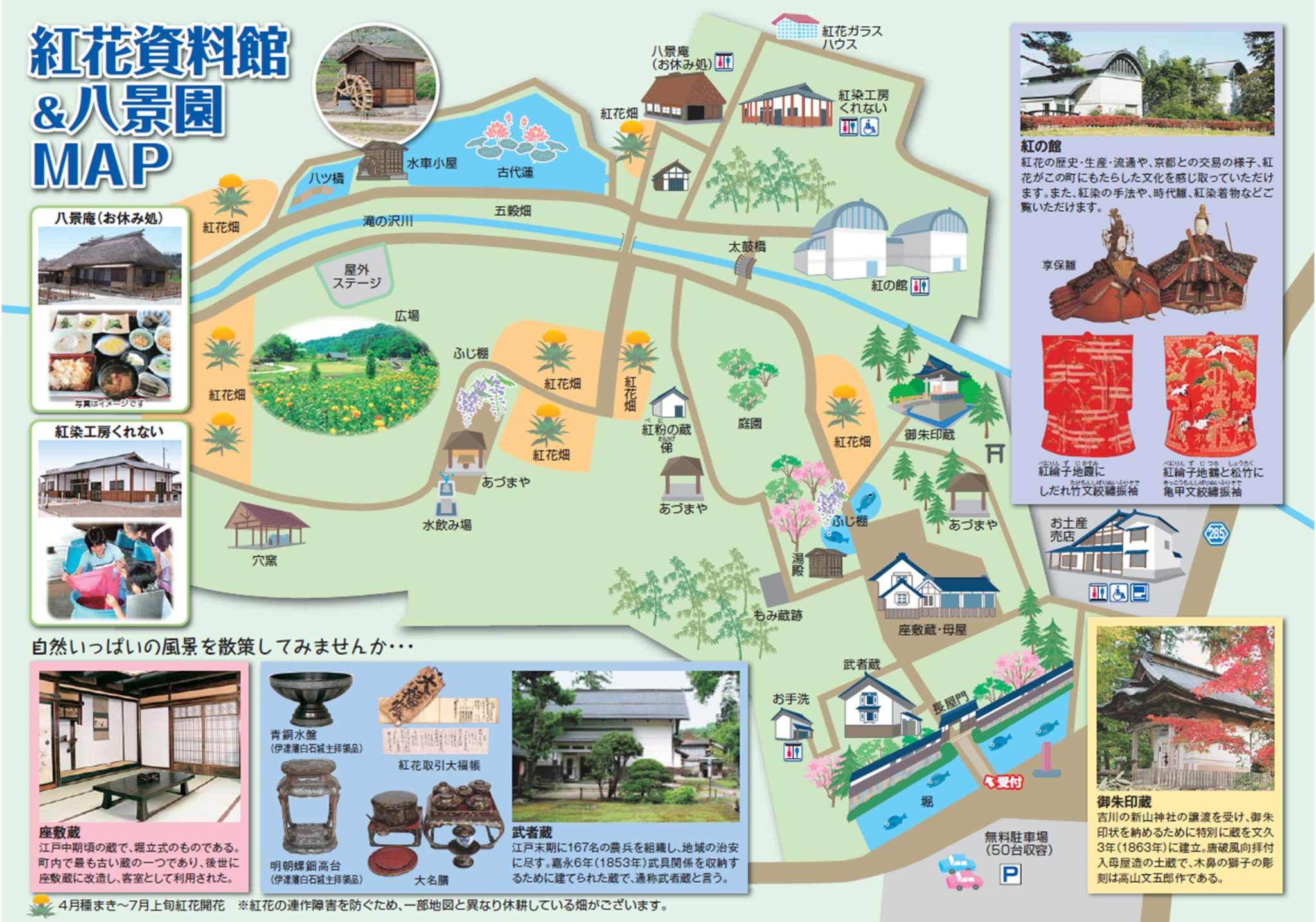
In the park, there are the samurai warehouse (weapon warehouse of the farmer’s corps), the tatami room (the warehouse that was used as a guest room), and the “Red House” that exhibited items from the time of the safflower trade.
* Safflower trade: A trade in which safflowers (safflowers) produced in Yamagata are sent to Kyoto and Osaka, and salt, cotton, daily necessities, and Hina dolls are loaded on the return ship.

Samurai warehouse
In the vast mansion, the river flows and there are red flower fields here and there, which is just the right size for a walk.
The “Safflower Studio Kurunare” that you will experience this time is located in the back of the mansion, so you can take a leisurely stroll.
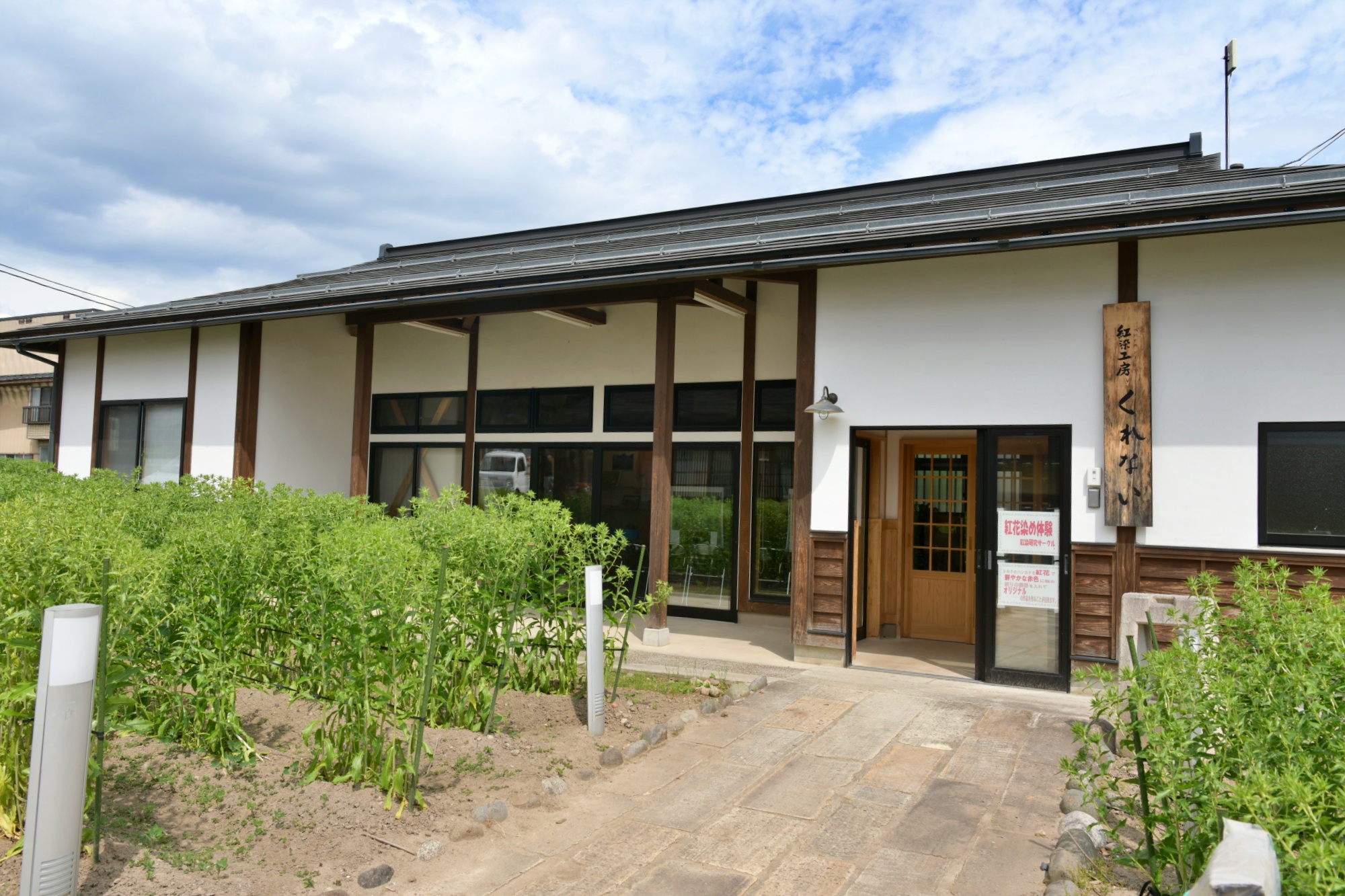
Upon arrival, safflowers were planted in front of the workshop.
I heard that it was in late June and that the flowers bloomed in early July.
2. First of all, from the orientation!
The experience starts immediately.
The members of the “Kahoku Town Safflower Dyeing Research Circle” will teach us this time.
First of all, while looking at the pictures, you will learn “until you can dye safflower”.
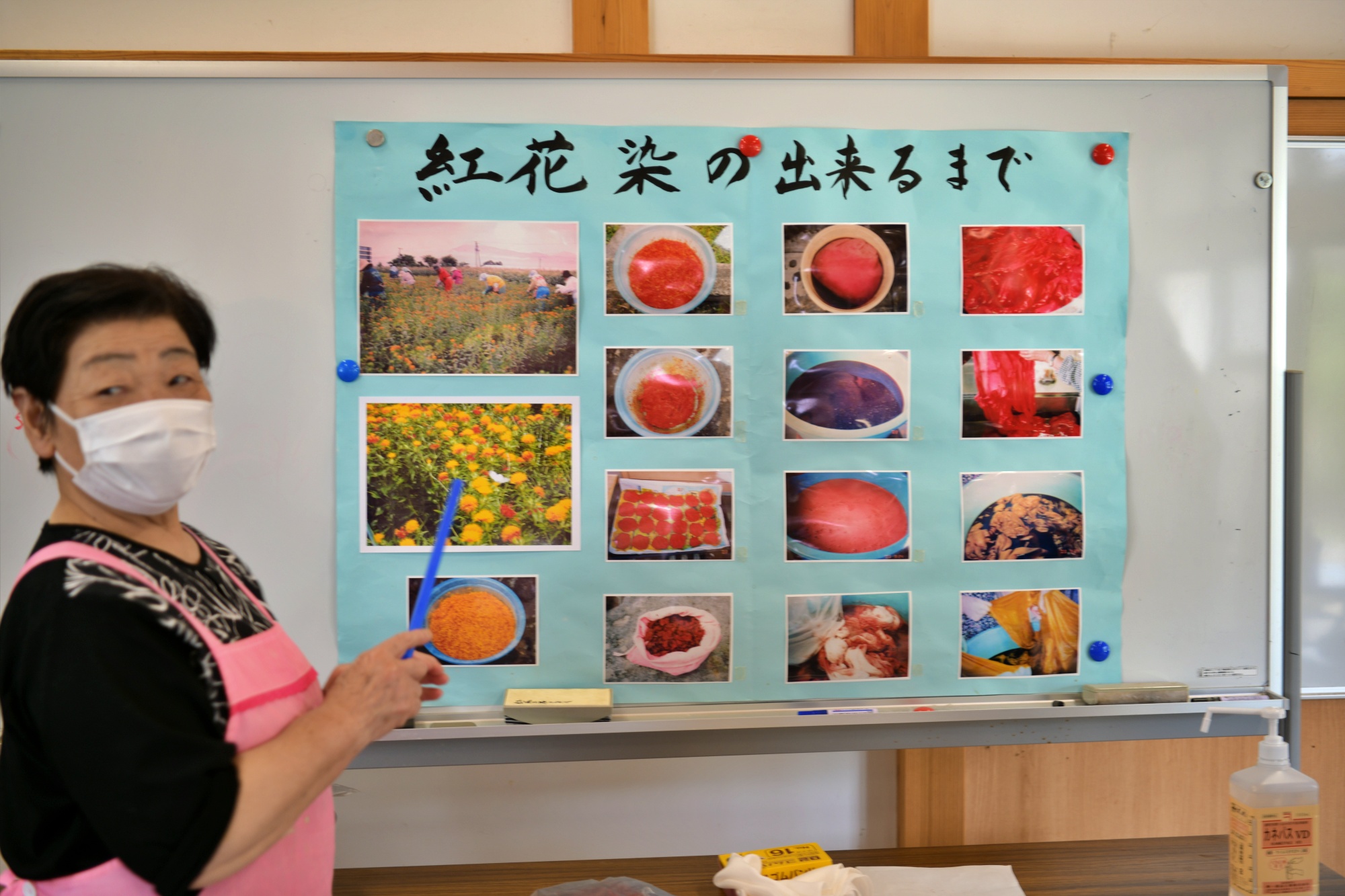
In order to dye safflower, the dyeing liquid must first be extracted from the raw material, safflower rice cake.
So what exactly is “red rice cake”?
We will introduce step by step how to make “red rice cake” which is the raw material and how to extract the dyeing liquid.
1. Until the red rice cake is made
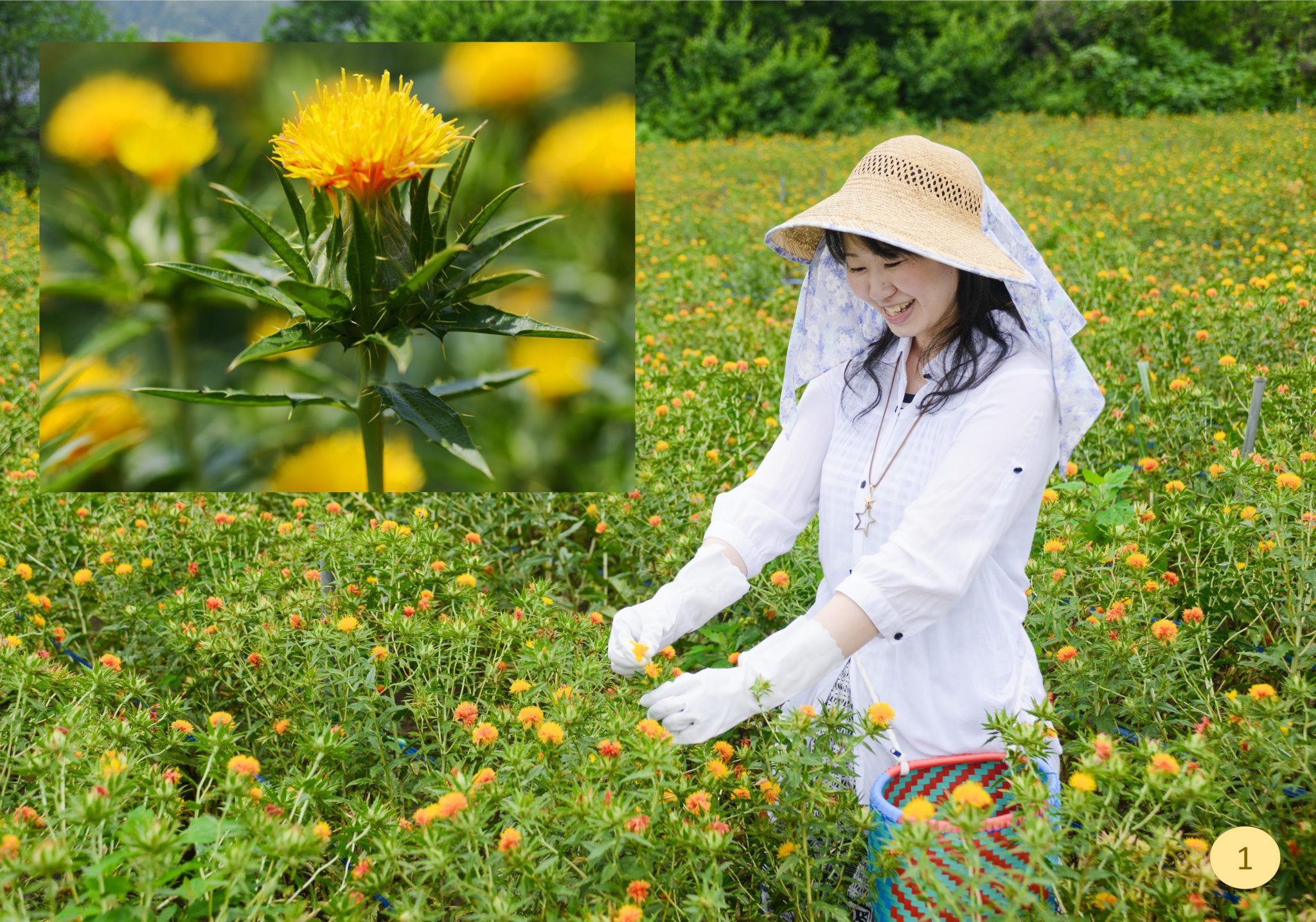
① First of all, it starts from picking safflower. Safflower has thorns, so it is a little troublesome. Pick while the thorns in the early morning are soft
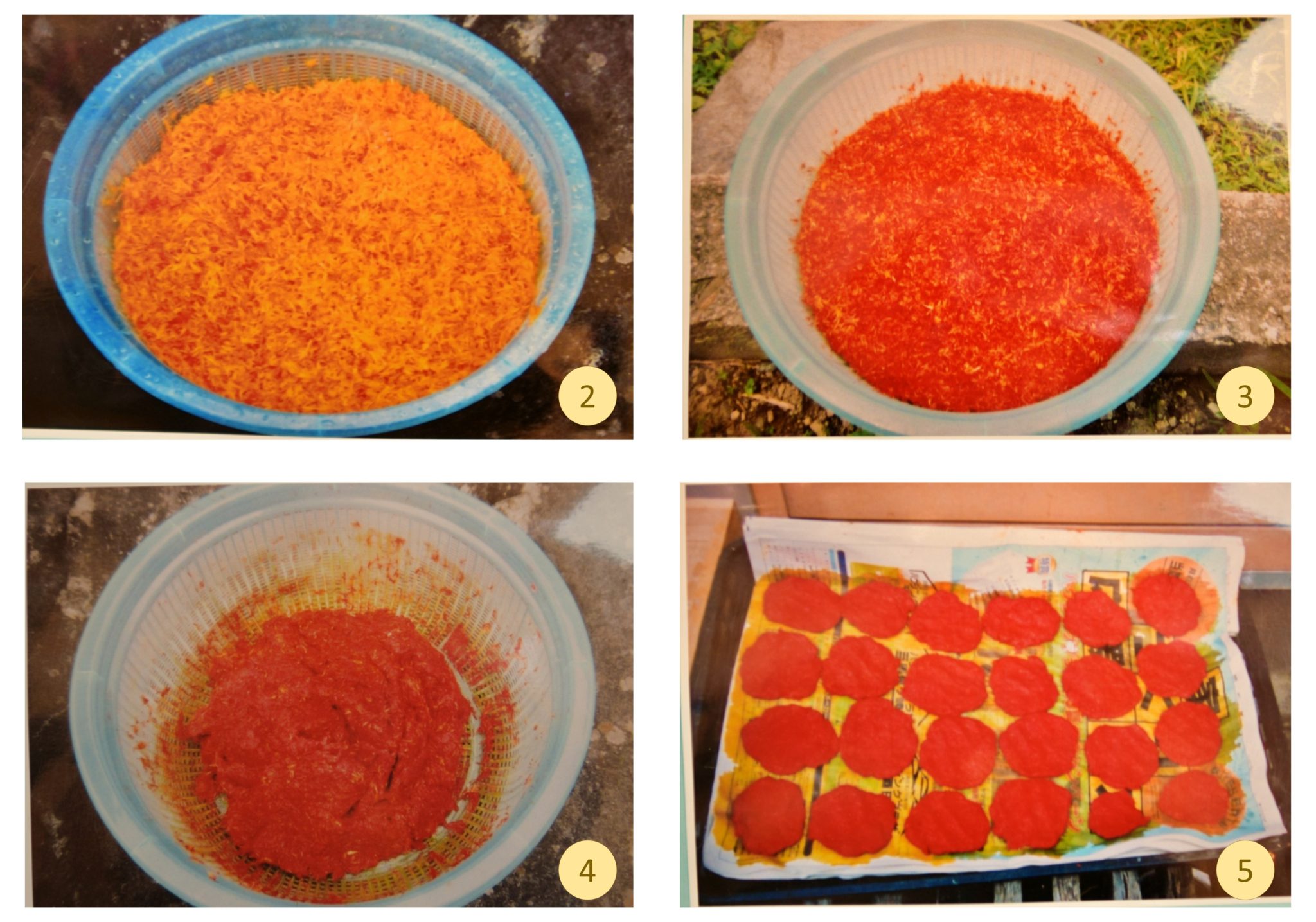
② Wash the picked petals with water.
③ After a few days, it will ferment and turn red.
④ Crush the red petals with a mortar.
⑤ Roll the crushed petals into dumplings, then flatten them and dry them in the sun.
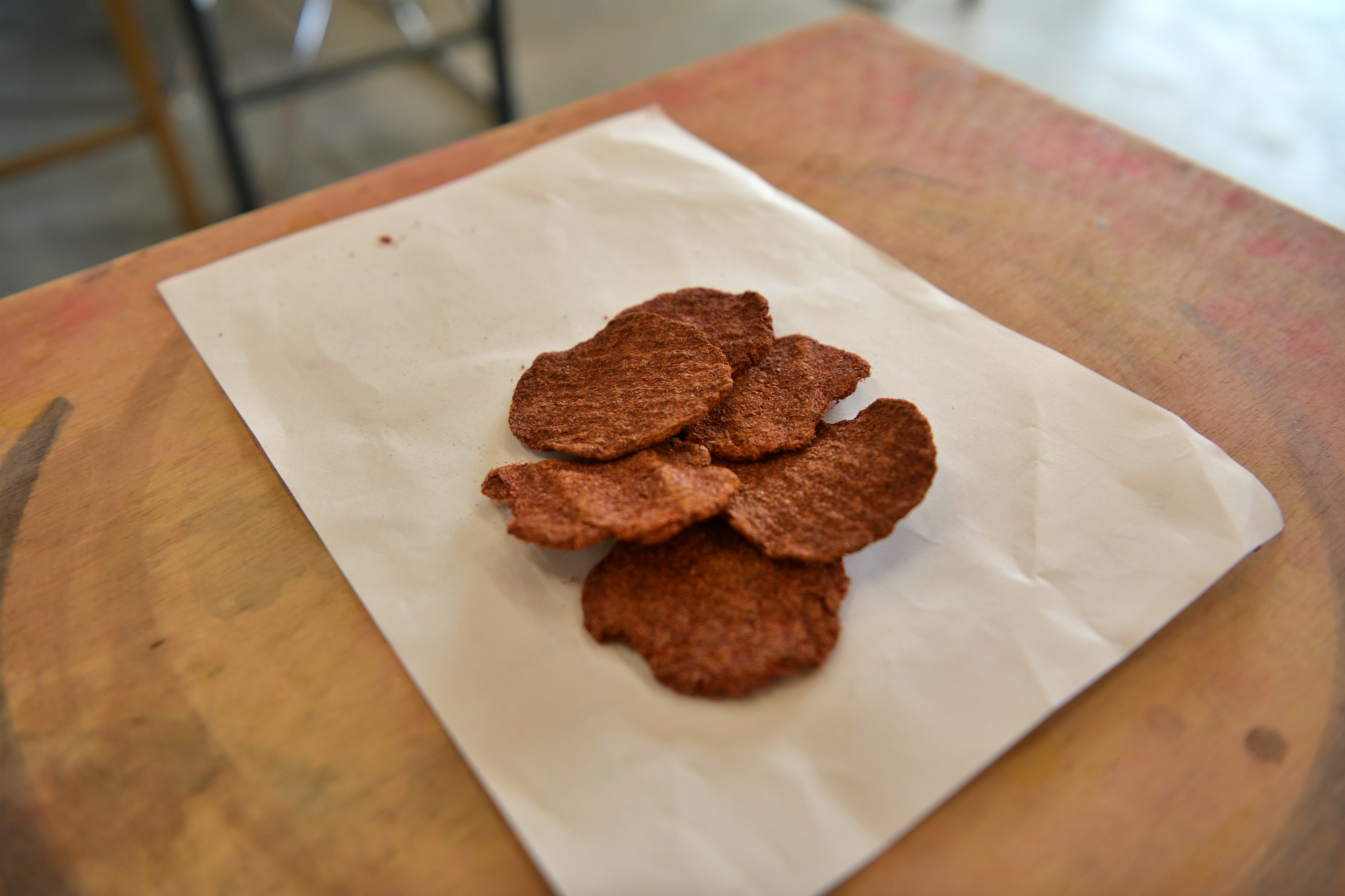
“Red rice cake” is made by removing water and drying.
2. Extract red from red rice cake
When you think of safflower, you immediately think of the colorful “safflower”.
However, safflower contains only 1% of red pigment.
The remaining 99% is yellow pigment, so for safflower dyeing, it is necessary to remove that 99% yellow from the red rice cake and extract 1% red.
You need a lot of red rice cakes to get only 1% red color, so you can see why safflower products are expensive!
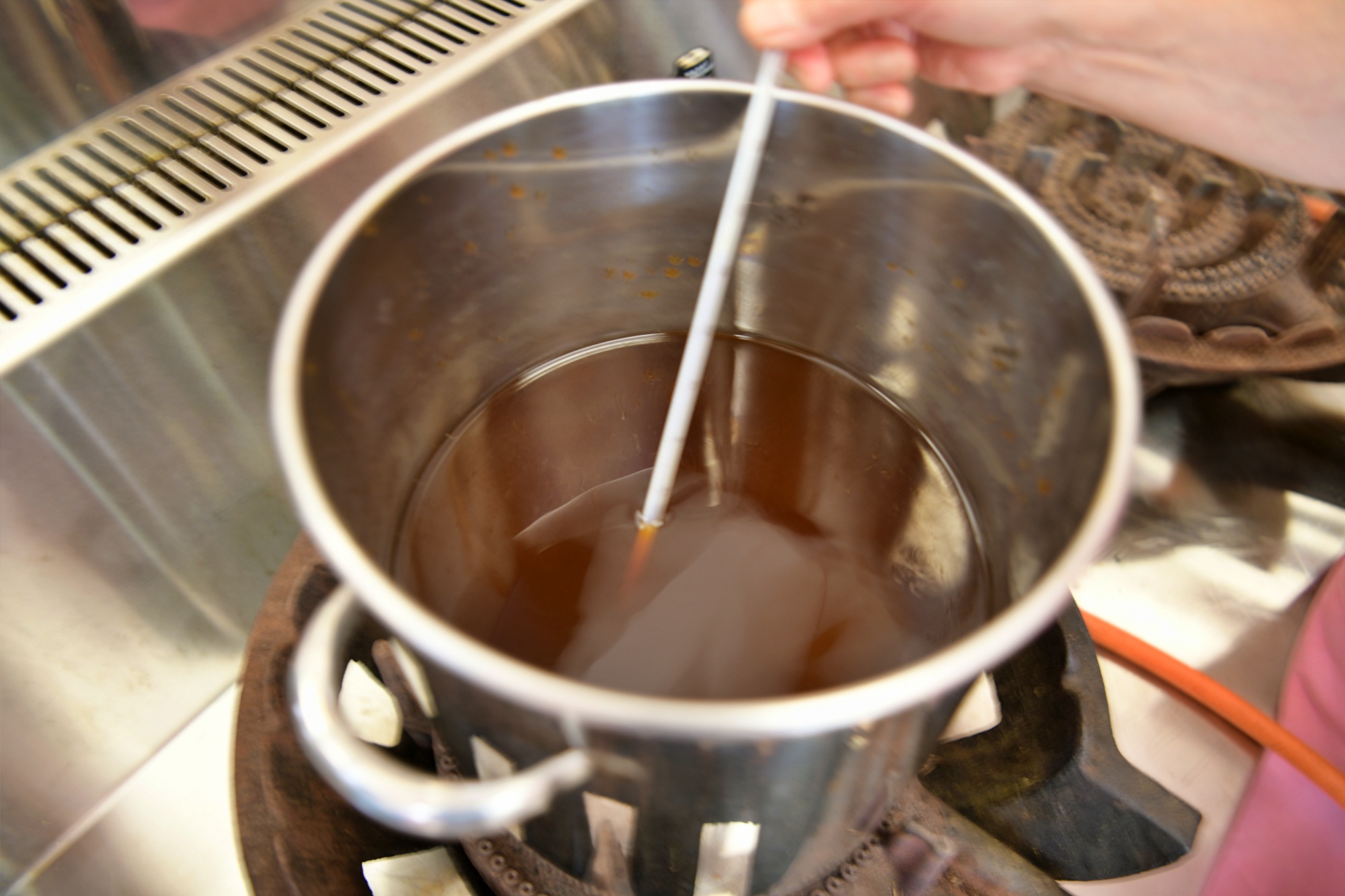
It takes 4 days * to extract the dyeing liquid from the red rice cake.
* In the case of Kahoku Town Safflower Research Circle
The following flow action is required.
[First day]
Put the red rice cake in a cloth bag in a bucket, soak it in water, and leave it for one day.
[Day 2 & Day 3]
Remove the yellow pigment while changing the water three times a day.
(The water that comes out first is used for the yellow dyeing solution, so save it.)
[Day 4]
・ Take the red rice cake out of the cloth bag, put it in a bucket, and add water. ・ Put potassium carbonate dissolved in water in the bucket containing the red rice cake and leave it for 1 hour. ・ Return the red rice cake to the bag and squeeze it. The liquid that comes out becomes a ” dyeing liquid “
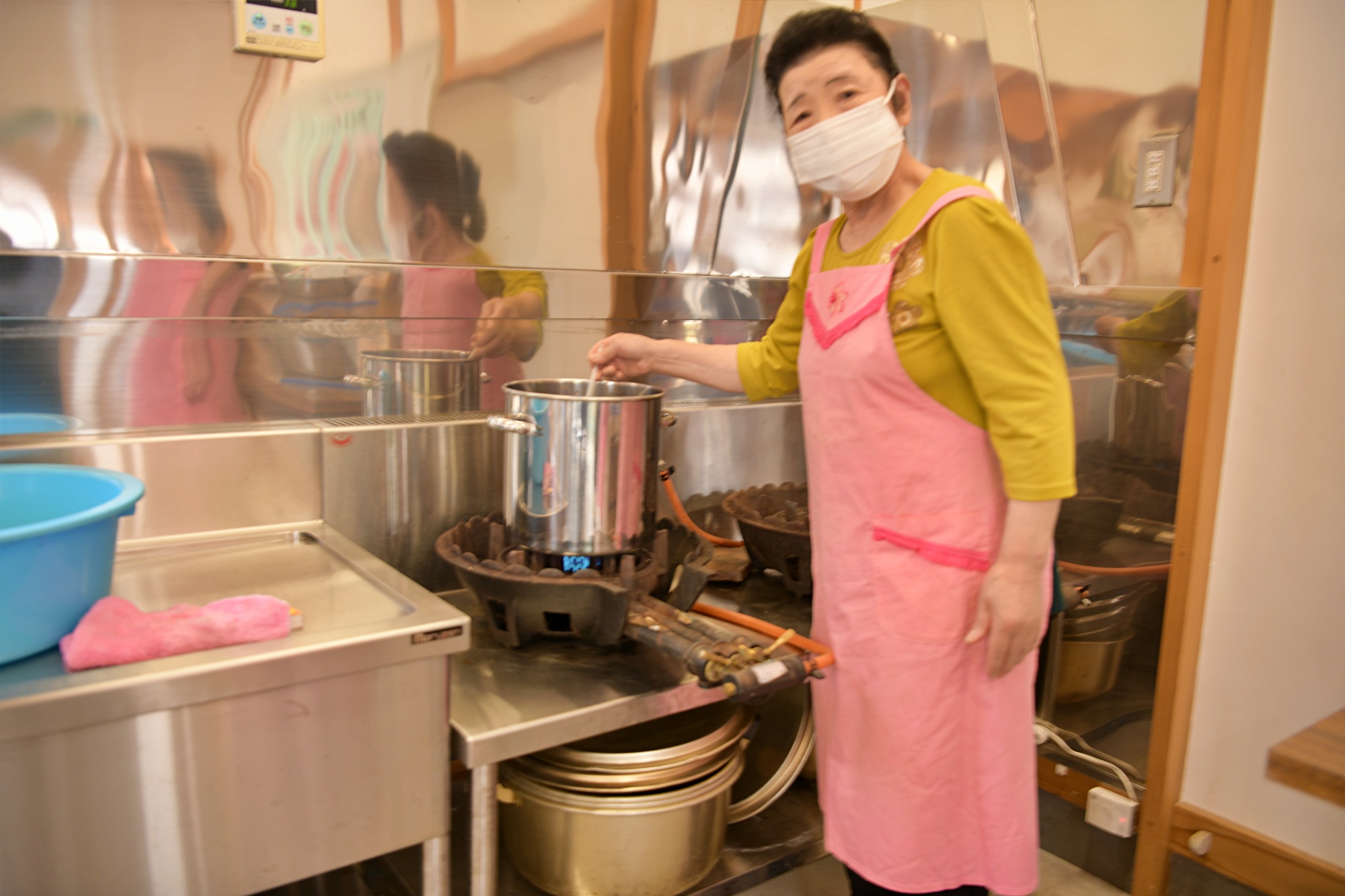
The “dyeing liquid” used in the safflower dyeing experience at the Benibana Museum will be made in advance by the instructor of the “Kahokucho Benibana Research Circle”.
Since the “dyeing liquid” is made after the customer makes a reservation, the reservation for the safflower dyeing experience is supposed to be more than 5 days in advance.
3. Safflower dyeing experience
① Material
Now, the experience is about to begin.
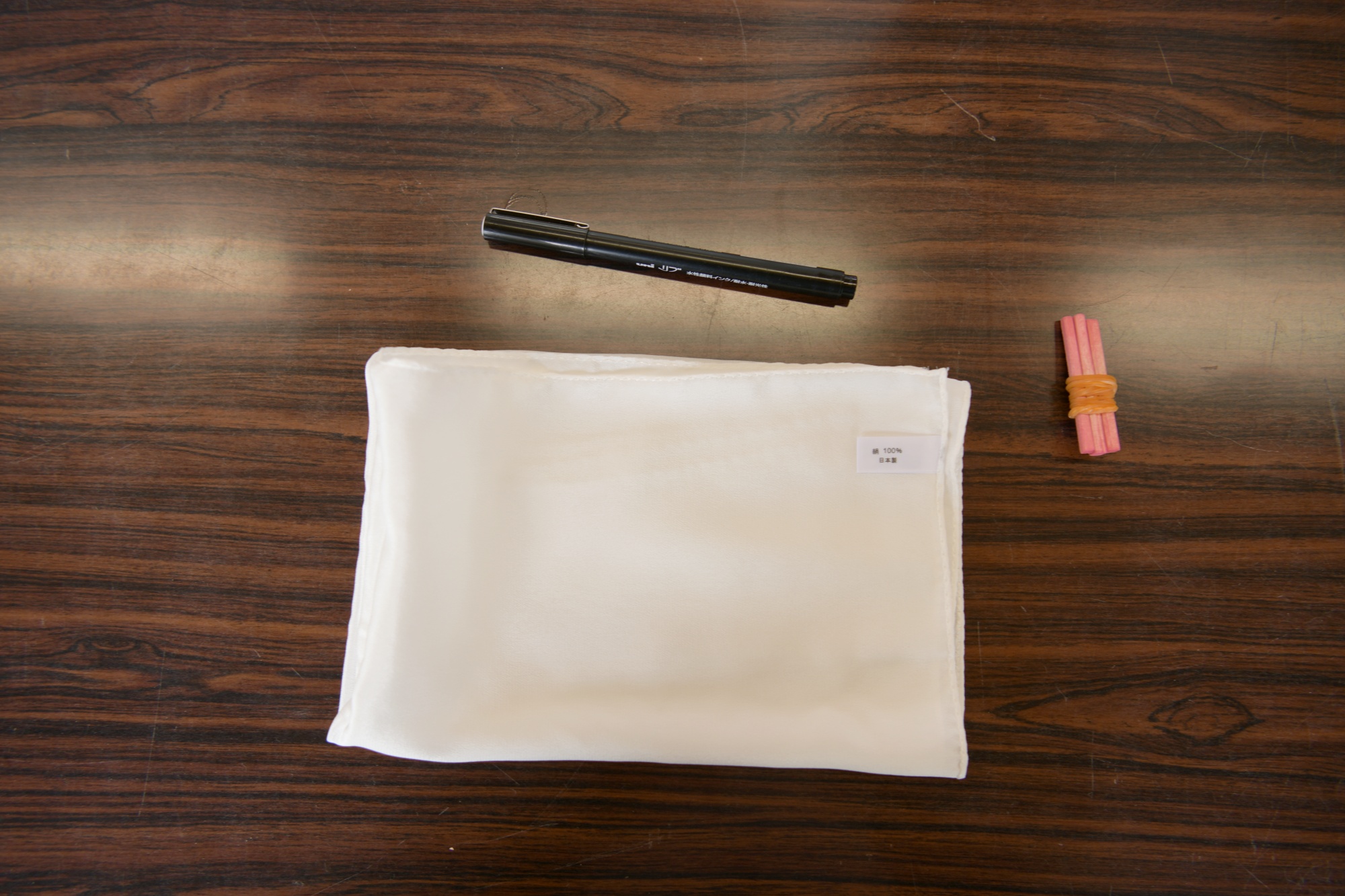
These three materials.
Silk handkerchiefs, wooden sticks, rubber bands.
(The pen is used to mark your tag on the tag)
Expectations are high for what color this pure white handkerchief will be dyed.
② Add a squeeze pattern to the handkerchief
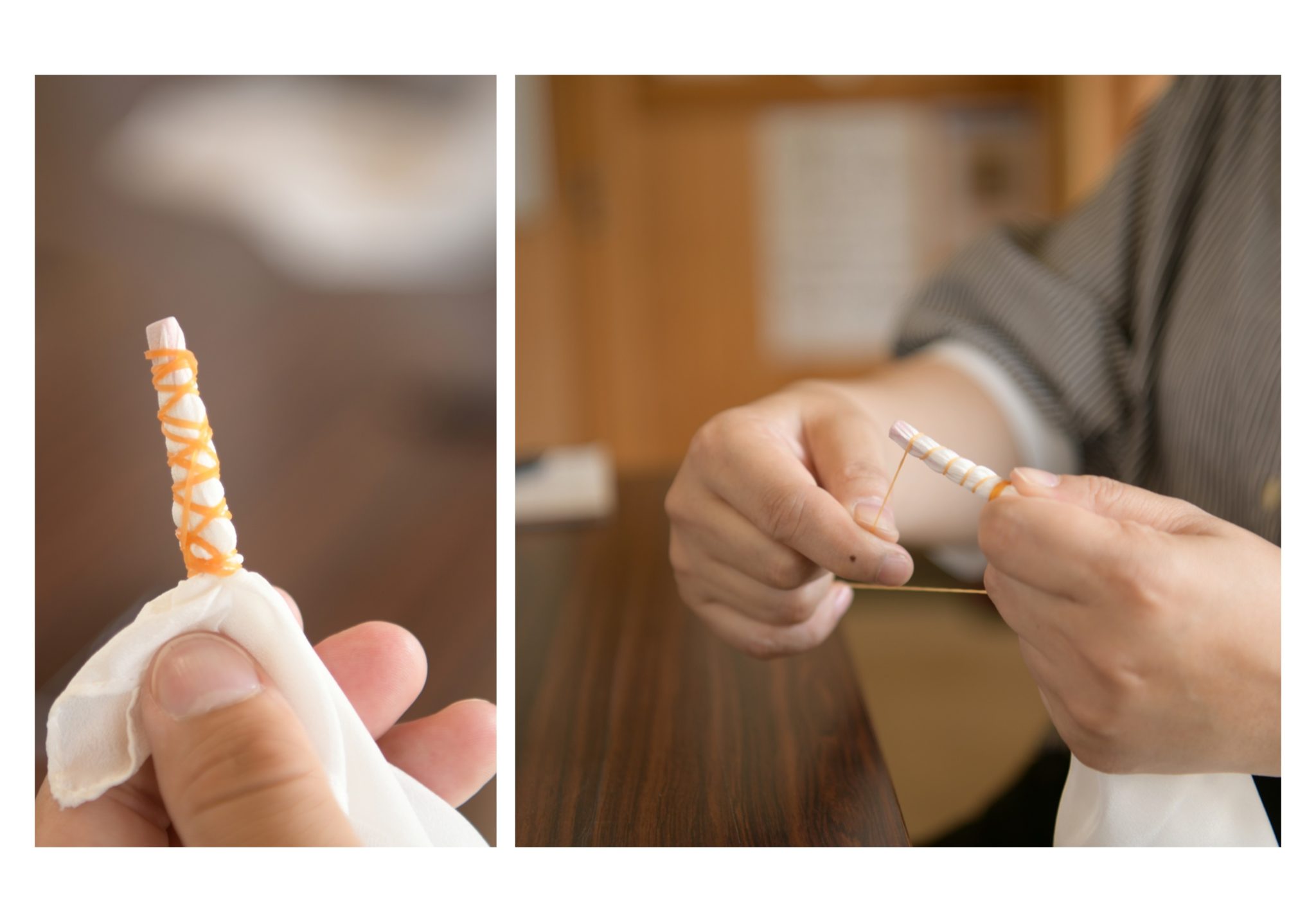
First, make a squeeze pattern.
Think about where to make the squeeze on the handkerchief and tie it tightly with rubber.
It’s easy to work with, but it’s hard to decide the position!
There are 3 sticks, so you can make 3 sticks, but you can make 2 sticks or arrange them to your liking.
③ Put a handkerchief in the dyeing liquid
Now, finally, soak the cloth in the dyeing solution.
The first soaked liquid has a yellowish red color.
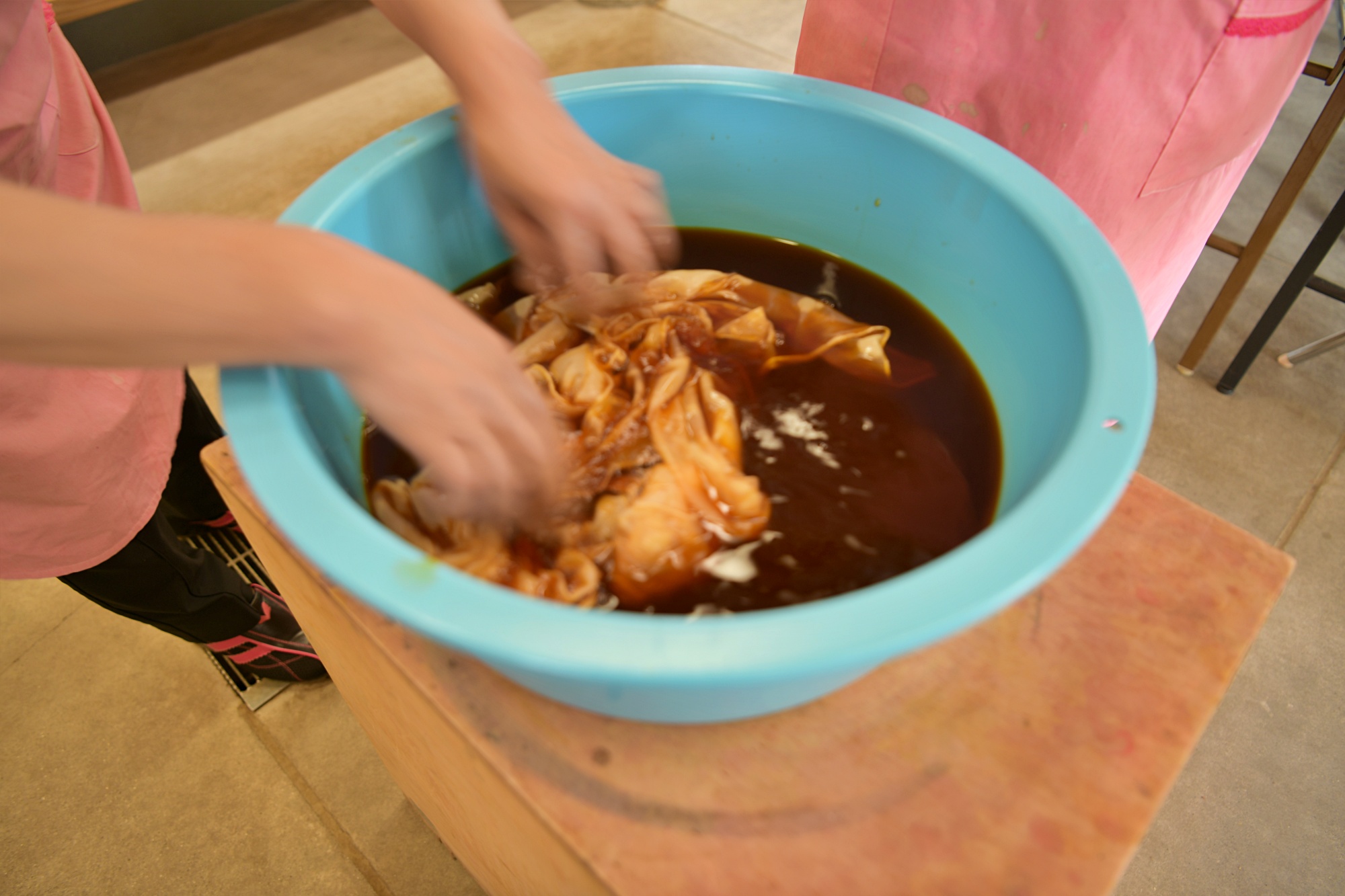
When I dipped the cloth in this liquid, it became like a bright yellow color.
At this point it is not yet red.
④ Add citric acid
From here, an interesting phenomenon like a science experiment begins.
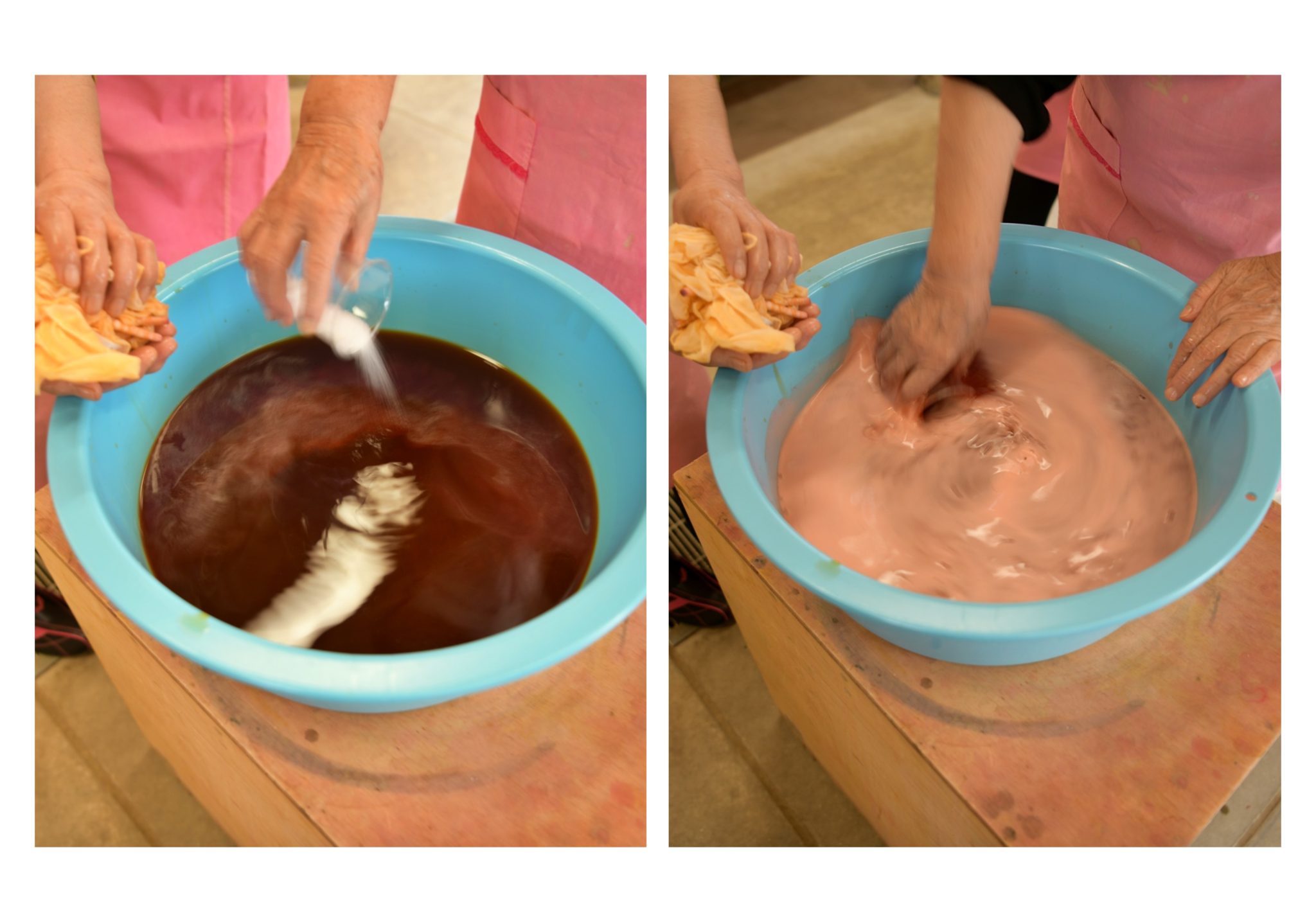
Add citric acid to the liquid and stir.
Then, the liquid began to turn white and cloudy, and bubbles appeared.
By adding citric acid, the alkaline liquid is neutralized, and the red pigment is fixed on the cloth to improve the color development.
Now, soak the cloth in this dyeing solution again.
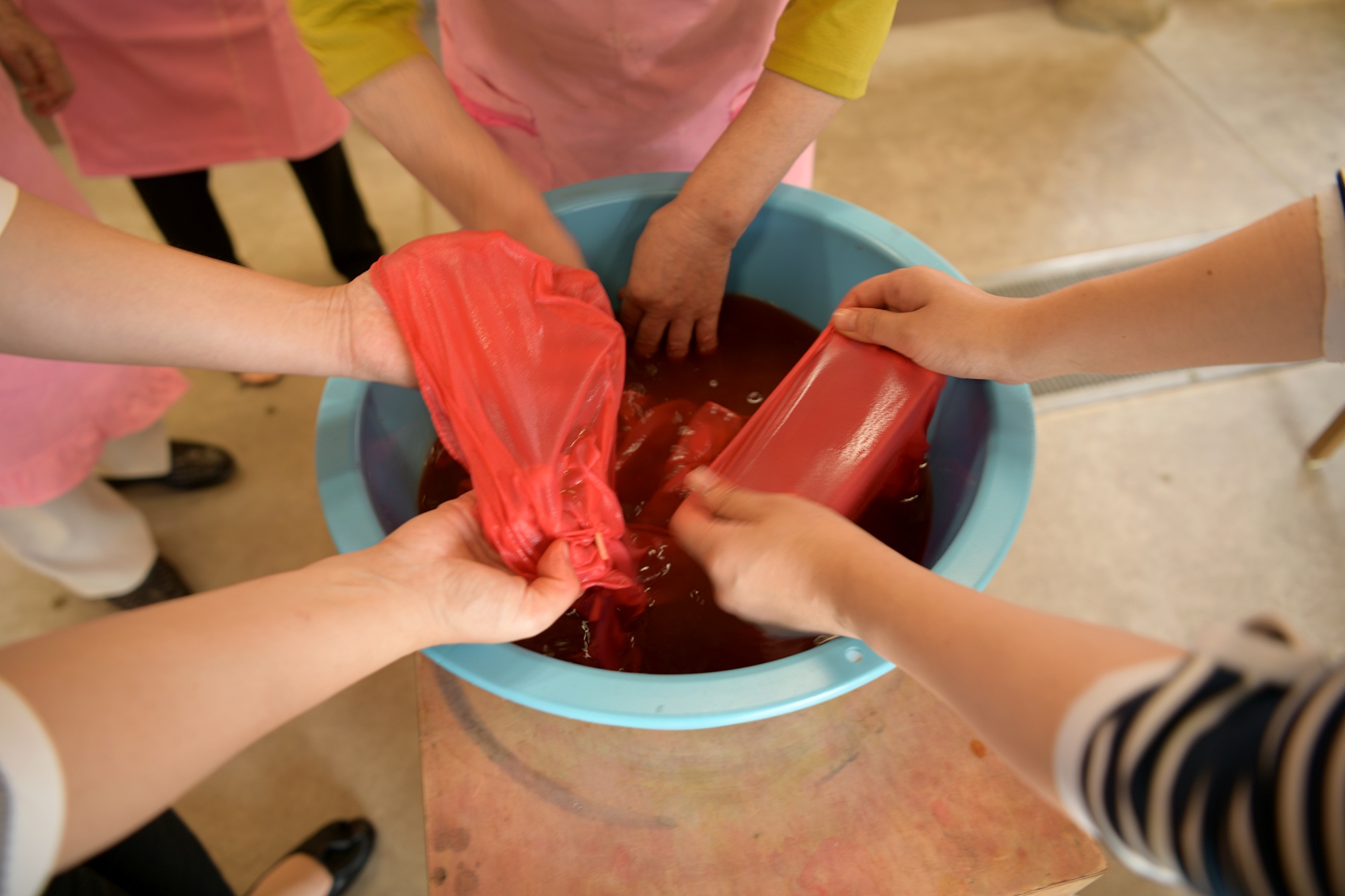
The color has changed from the previous Yamabuki color to a crimson color.
For 15 minutes from here, lightly rub the cloth and let the color blend in.
As time goes by, the color of the cloth becomes darker and darker.
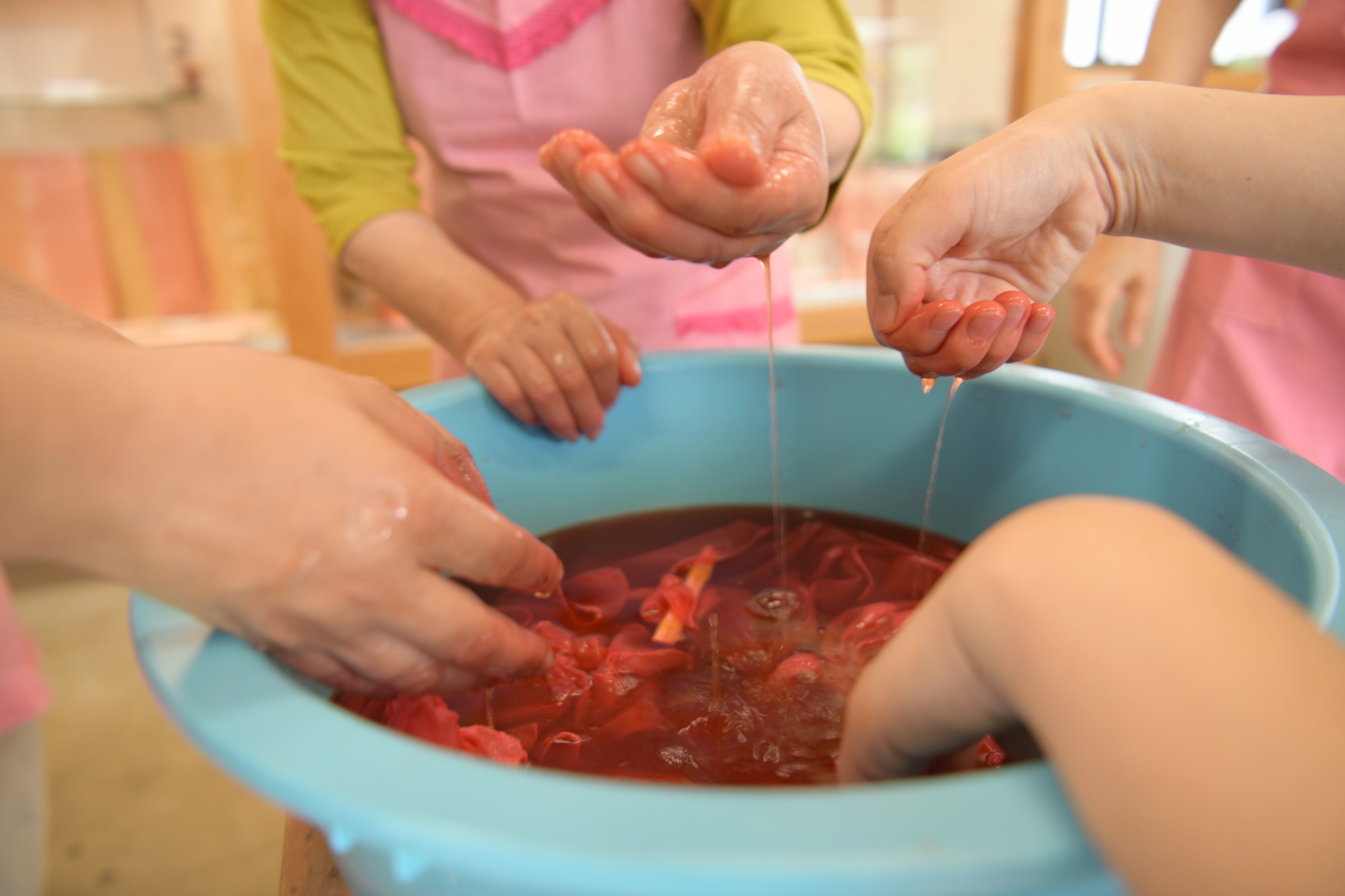
After a while, scoop up the dye and check the color.
When the red pigment is transferred to the cloth, the remaining liquid will turn yellow.
It’s strange …!
Then, when the red pigment is transferred to the cloth and the dyeing liquid turns yellow, it is a signal to finish the work.
⑤ Color stop
Next is the work of color fixing.
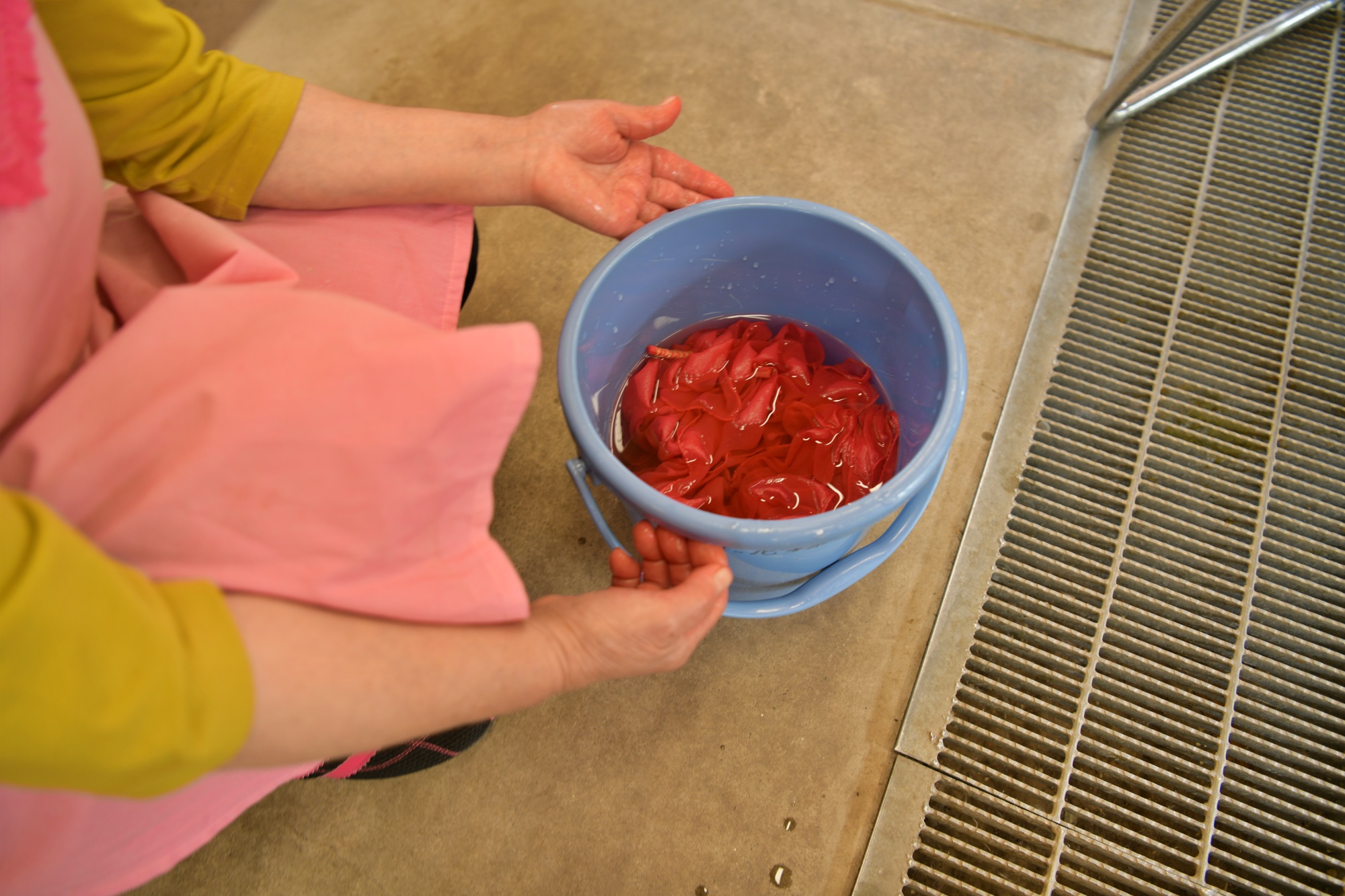
Soak the cloth removed from the dye solution in a bucket of glacial acetic acid for about 10 minutes.
⑥ Washing with water and dehydration
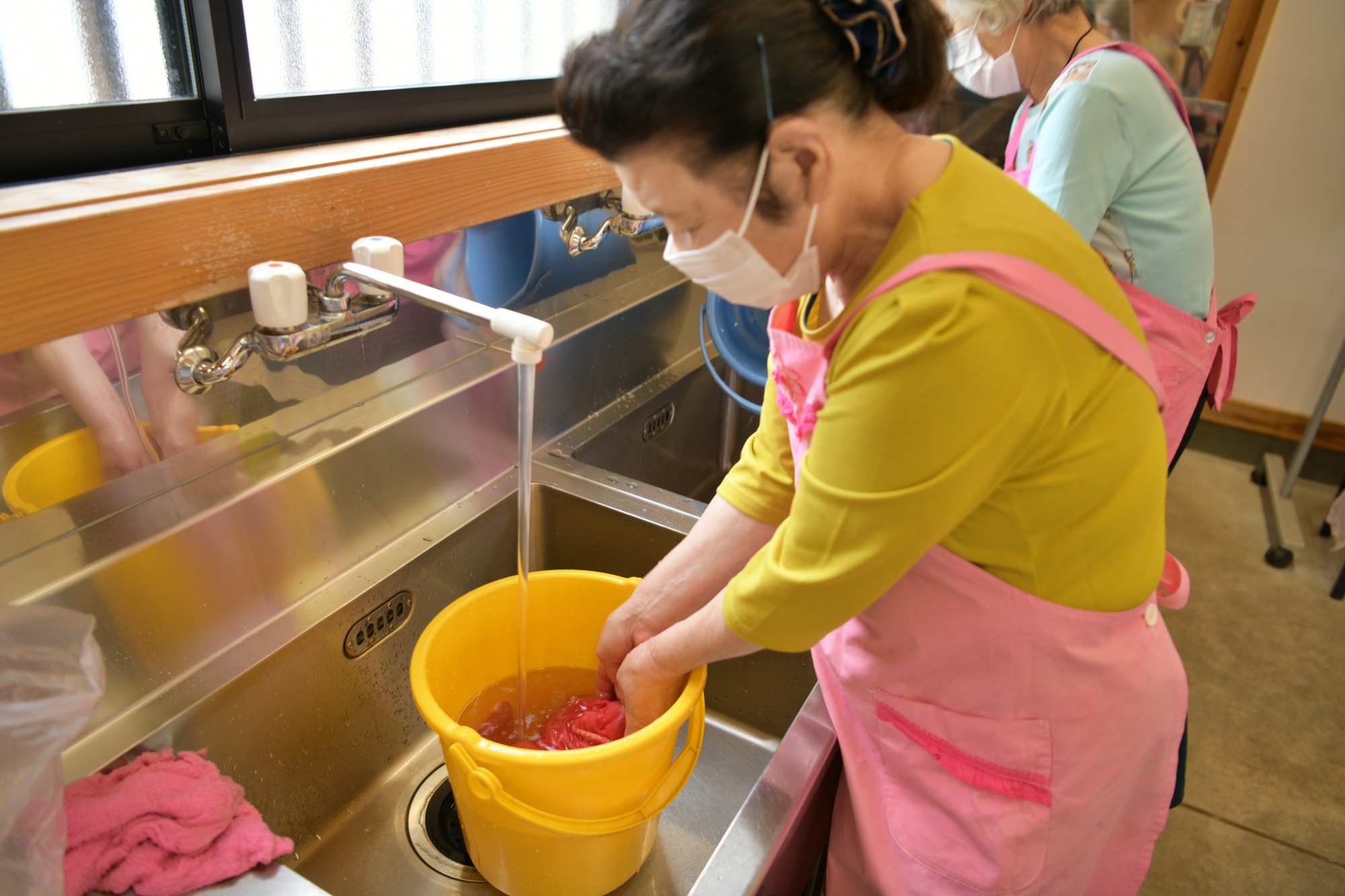
Rinse the colored cloth with water and dehydrate it.
From color fixing to dehydration, everyone in the safflower dyeing research circle will do it.
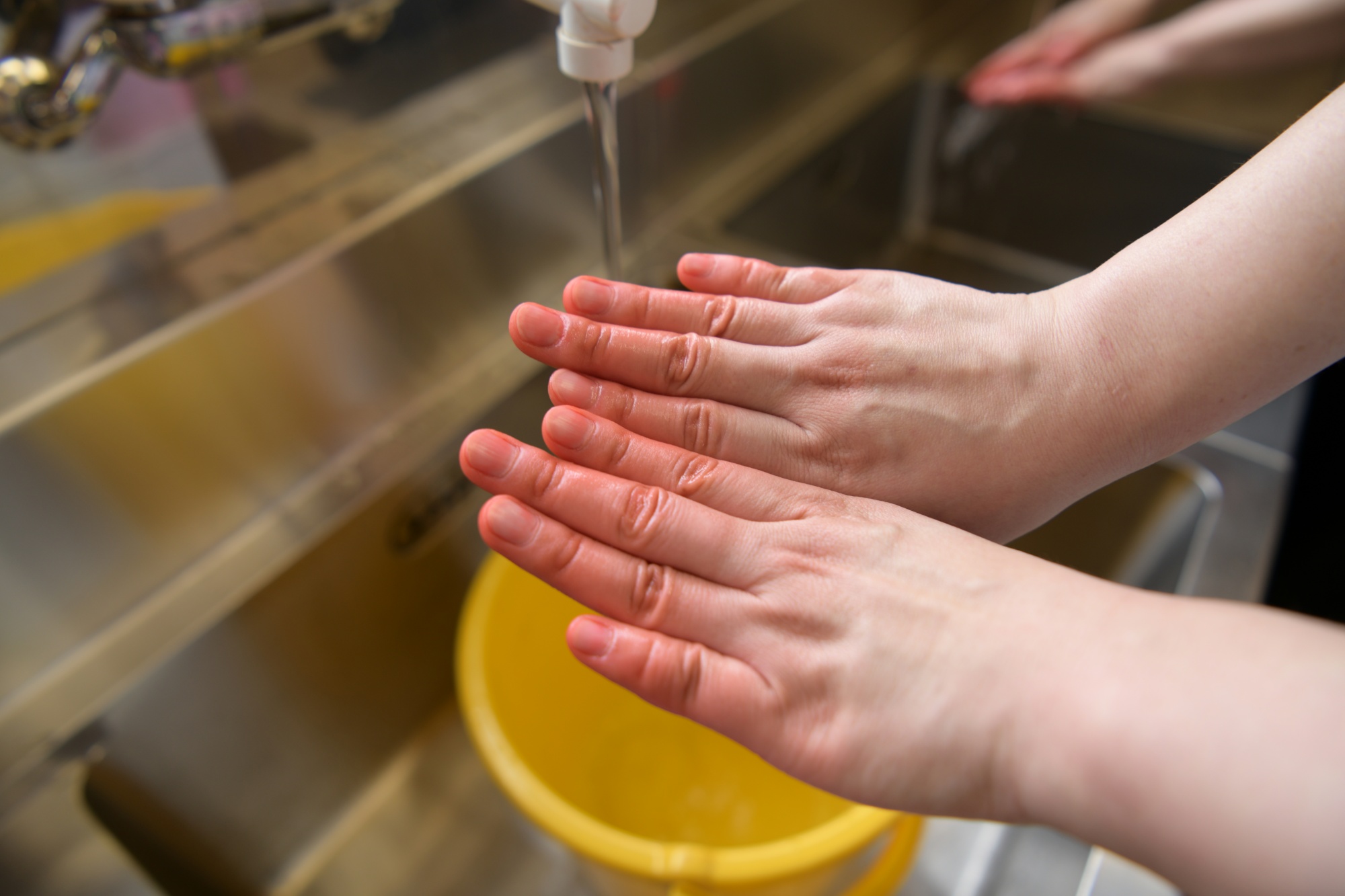
Look at this finger!
The cloth is dyed beautifully, but the hands are also bright red.
It seems that it will come off as soon as you apply soap, but I dared to leave the redness only by washing with water.
⑦ Remove the squeezed rubber
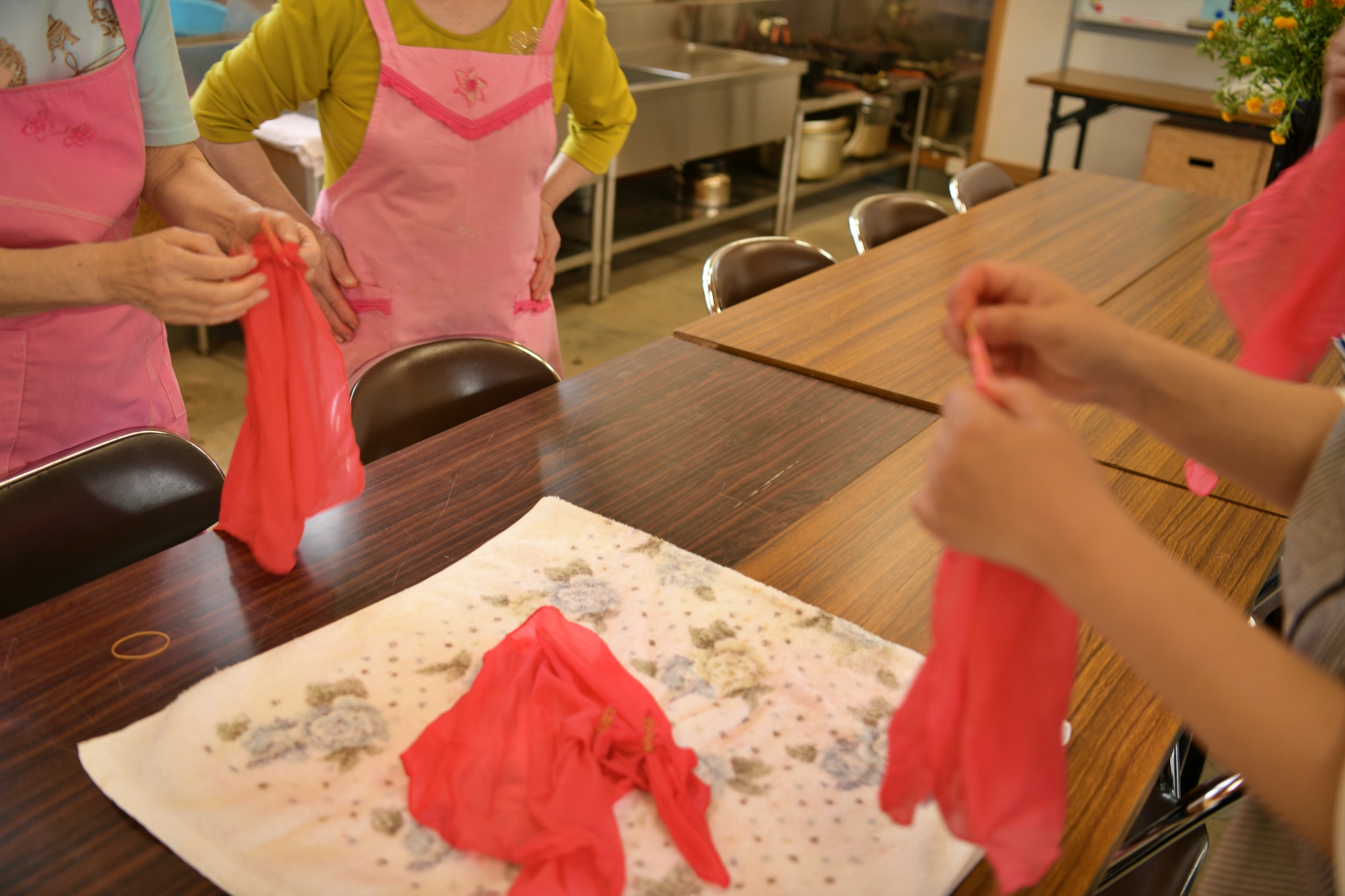
Next, I will remove the rubber that made the squeeze.
It’s a moment of tension to see what the pattern looks like!
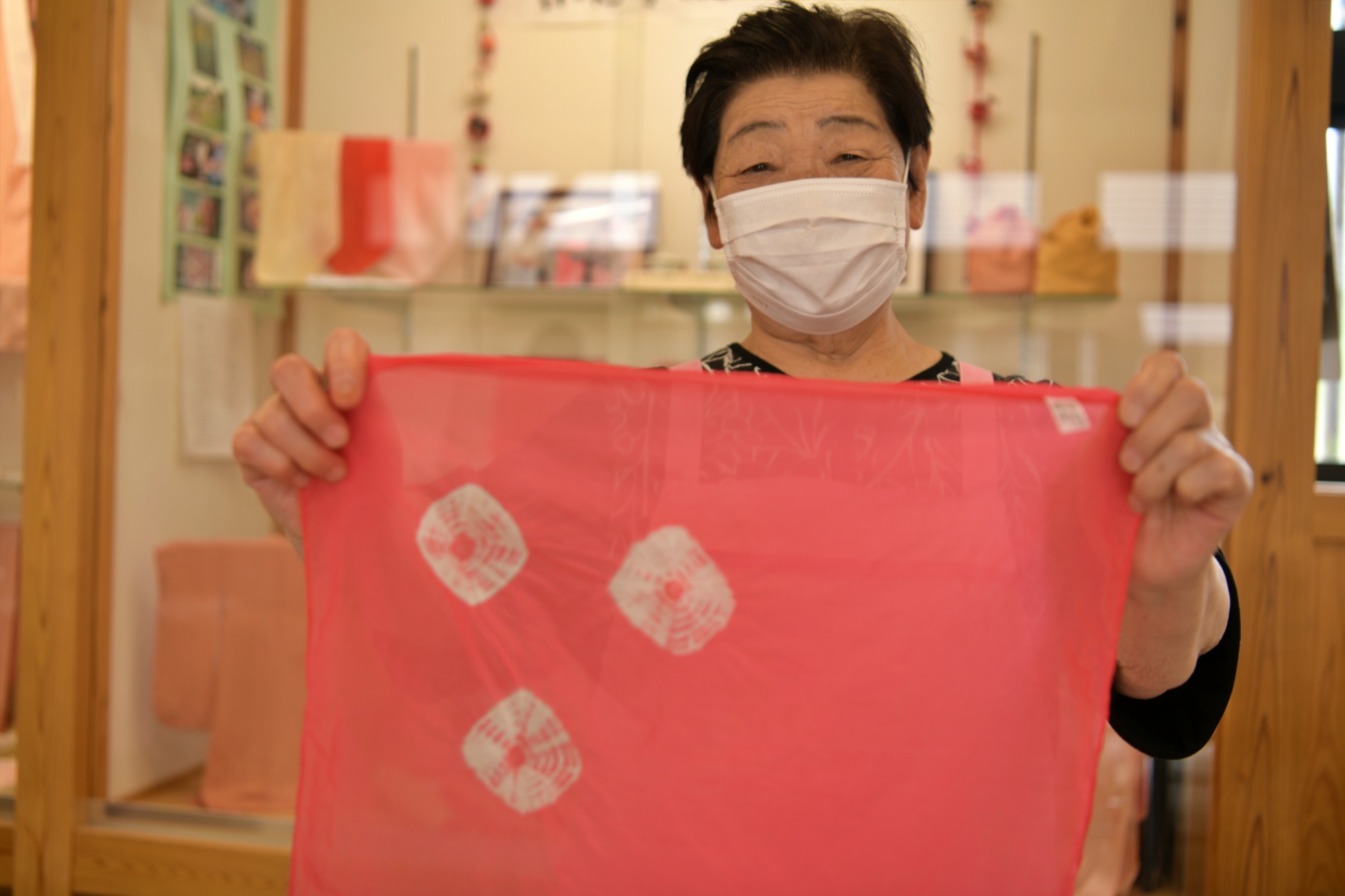
The part where the squeeze is made does not contain any color, so it remains the original white color.
It looks like a petal pattern and has a cute accent.
Where you make your own personality, depending on where you made the squeeze! !!
All the participants were satisfied with the result.
⑧ Iron
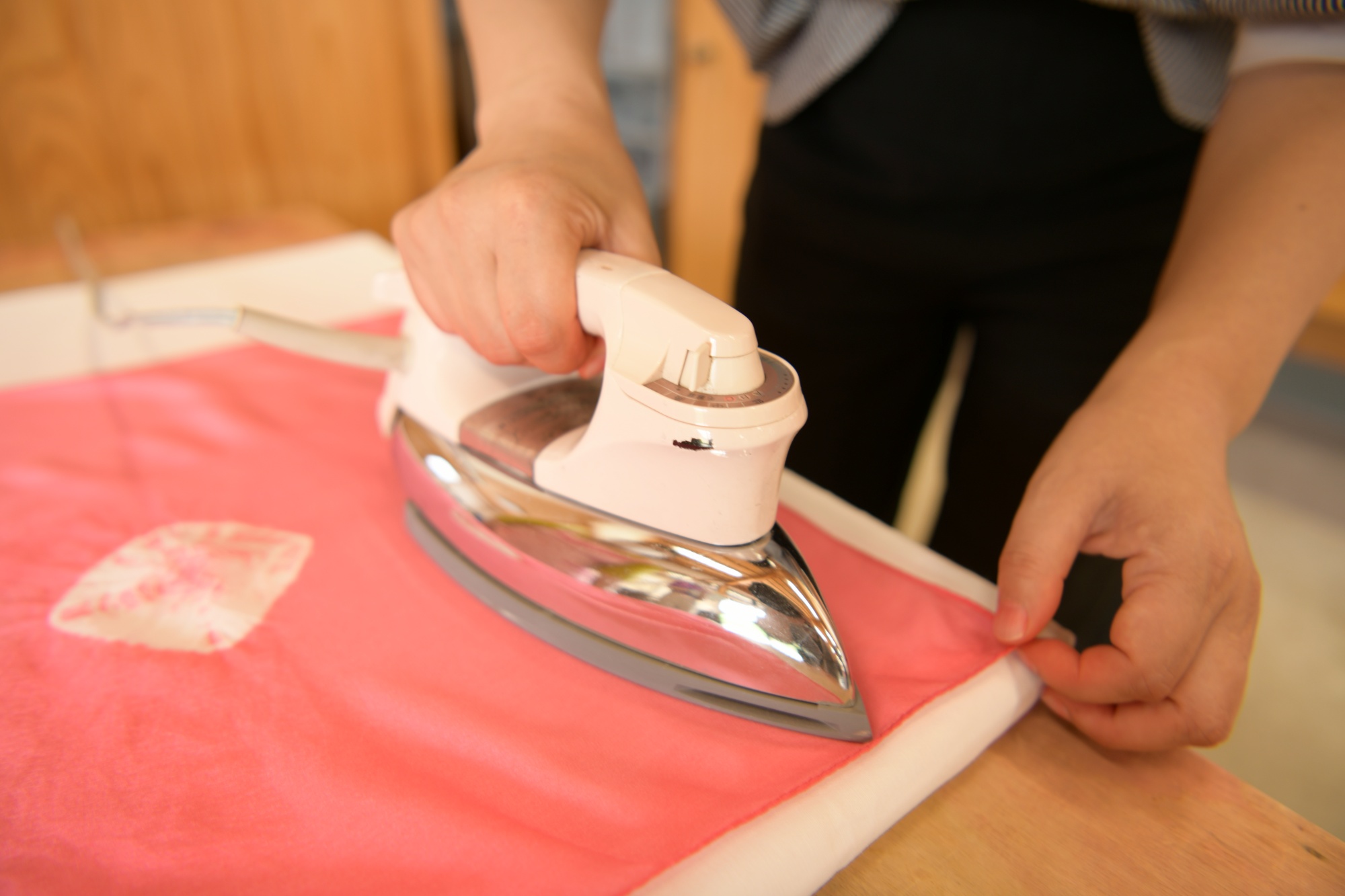
Iron the whole to finish.
When I applied it carefully while smoothing out the wrinkles, the wet handkerchief dried up, and the color changed further to become a calm color.
⑨ Complete
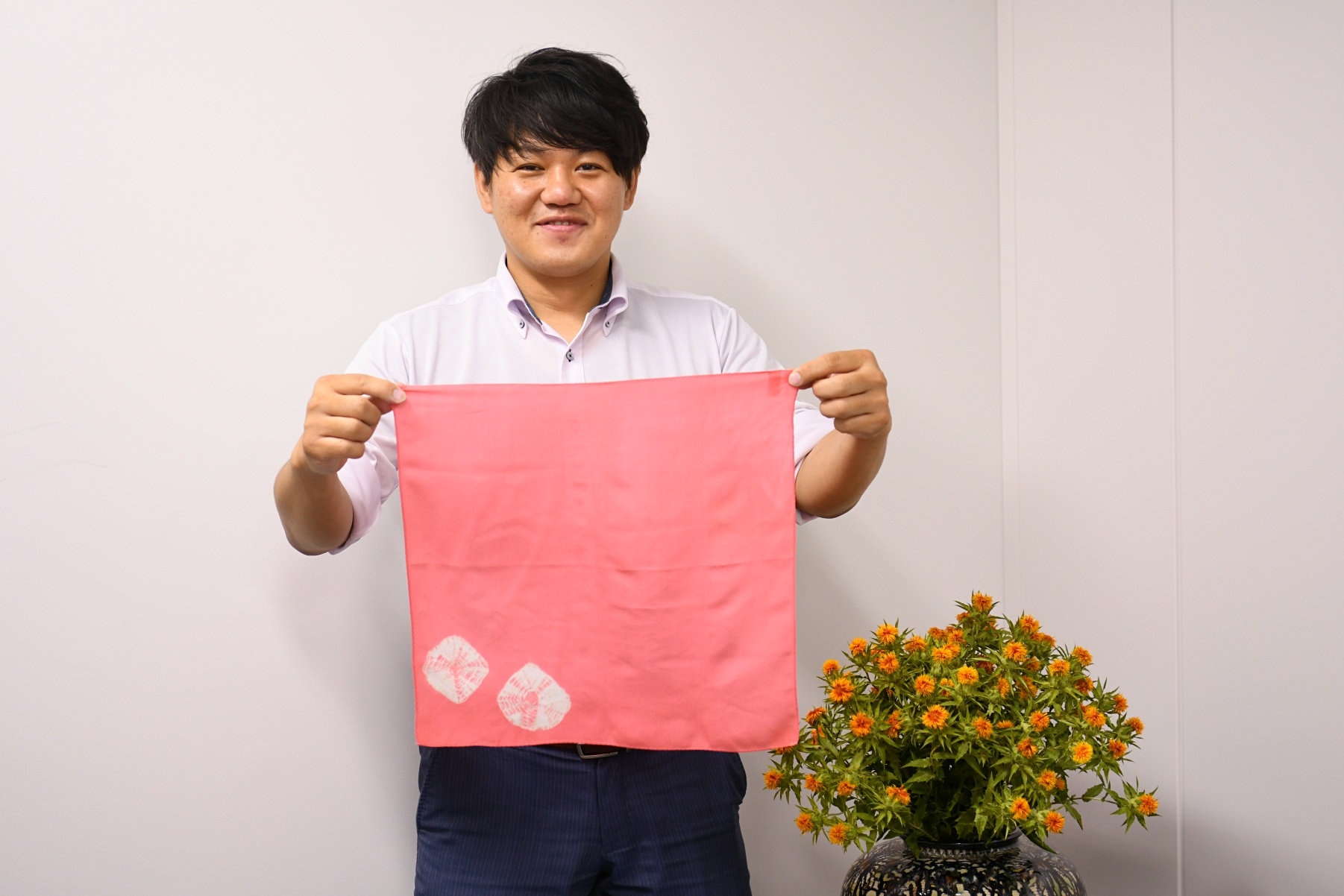
It was completed.
Look at this beautiful crimson!
Every corner is dyed firmly.
The fact that the white handkerchief is dyed so beautifully is the crimson color that has captivated the hearts of females for a long time, and it is still fascinating over time.
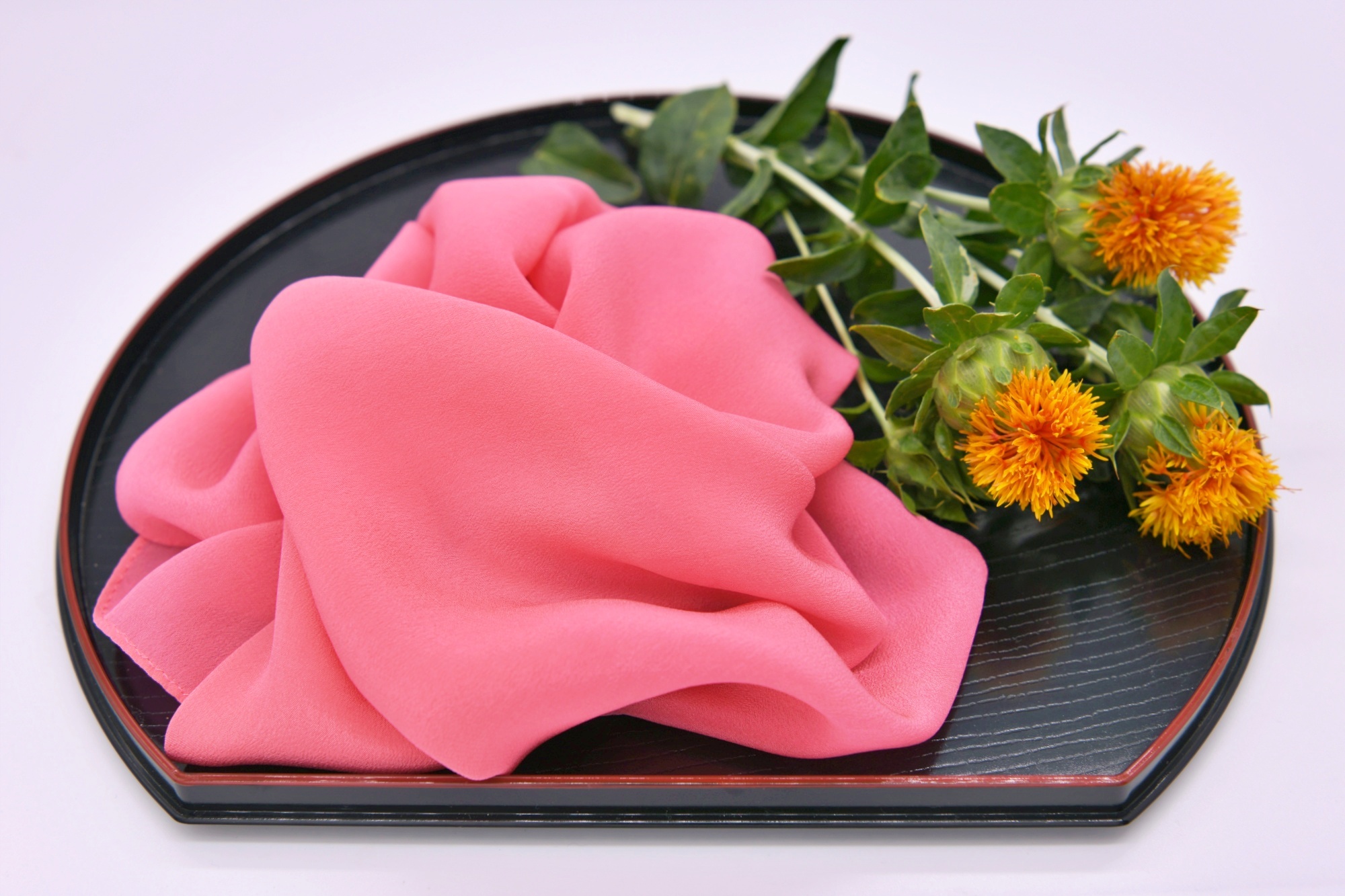
4. Stop by the product building
After the experience, I stopped by the product building.
Inside the store, you can find products related to safflower and special products from Hebei Town.
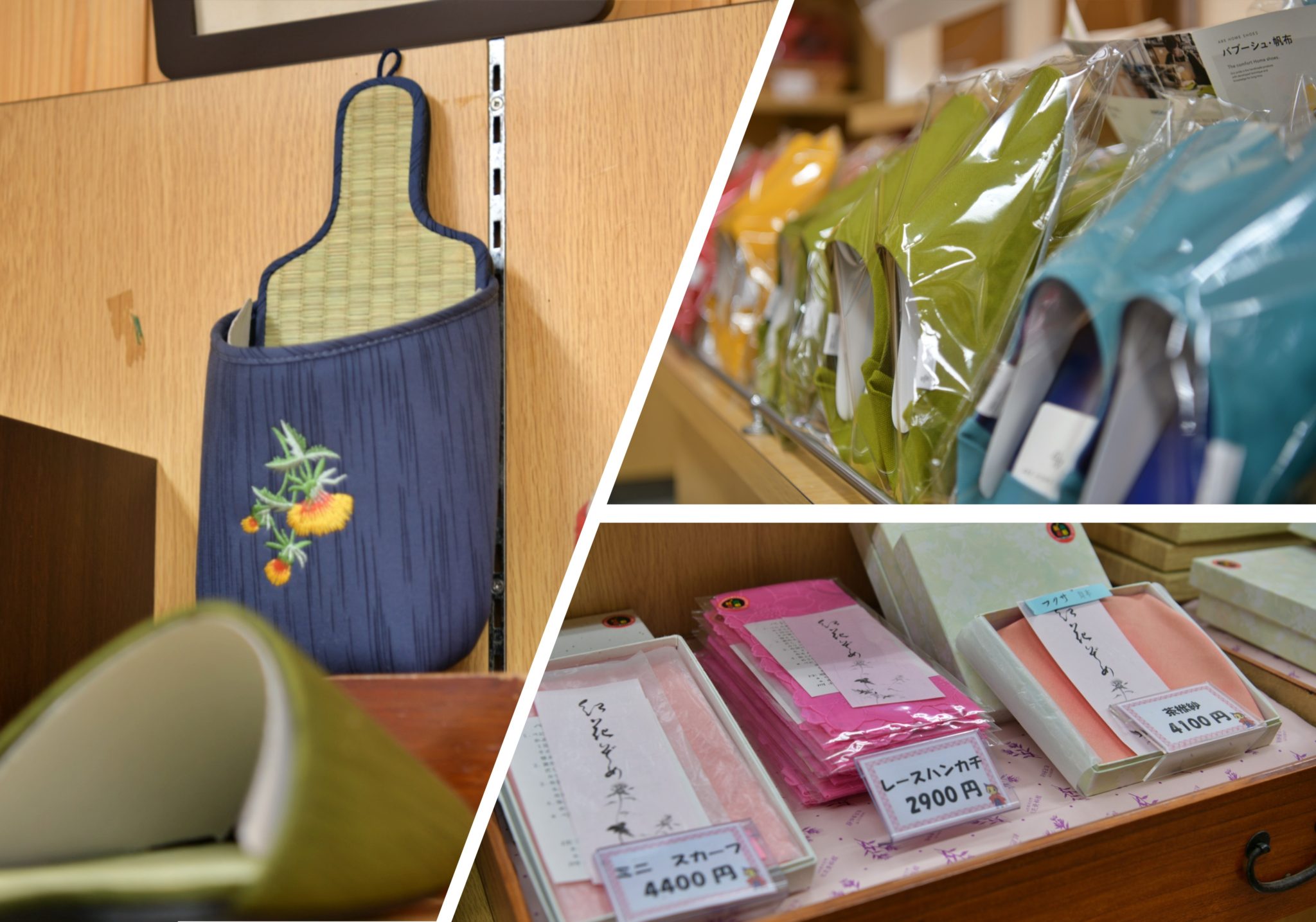
Speaking of Kahoku town, slippers. The colorful babouche is also very nice and you will want to have all the colors.
In addition to handkerchiefs and scarves dyed with safflower, there are also products that are rarely seen, such as safflower tea and petals used as food coloring.
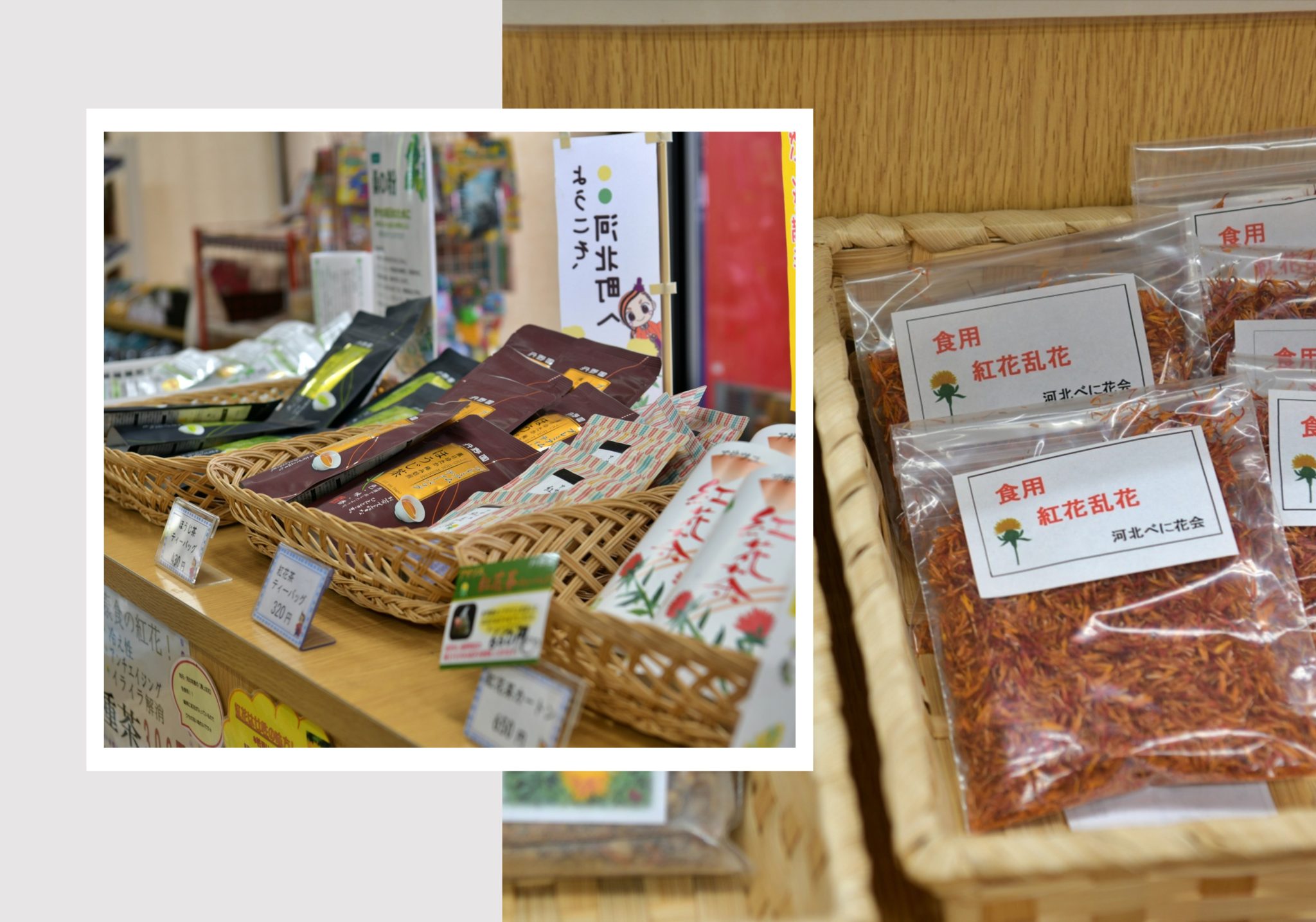
In addition, coffee and sweets are available at the rest area, which is recommended for taking a break between walks.
5. Message to everyone watching VISIT YAMAGATA
The three people who taught me this time are Miyoko Endo, Kimiko Suzuki, and Kiyoko Asakara from the Safflower Research Circle in Kahoku Town.
There are currently 18 safflower dyeing research circles.
At the monthly study session, not only safflower dyeing but also research on dyeing that combines plant dyeing such as tea, turmeric, onions, chestnuts, and indigo with safflower dyeing is being conducted.
The teachers who taught me this time have been involved in dyeing for a long time and have conveyed the appeal to many people from children to adults.
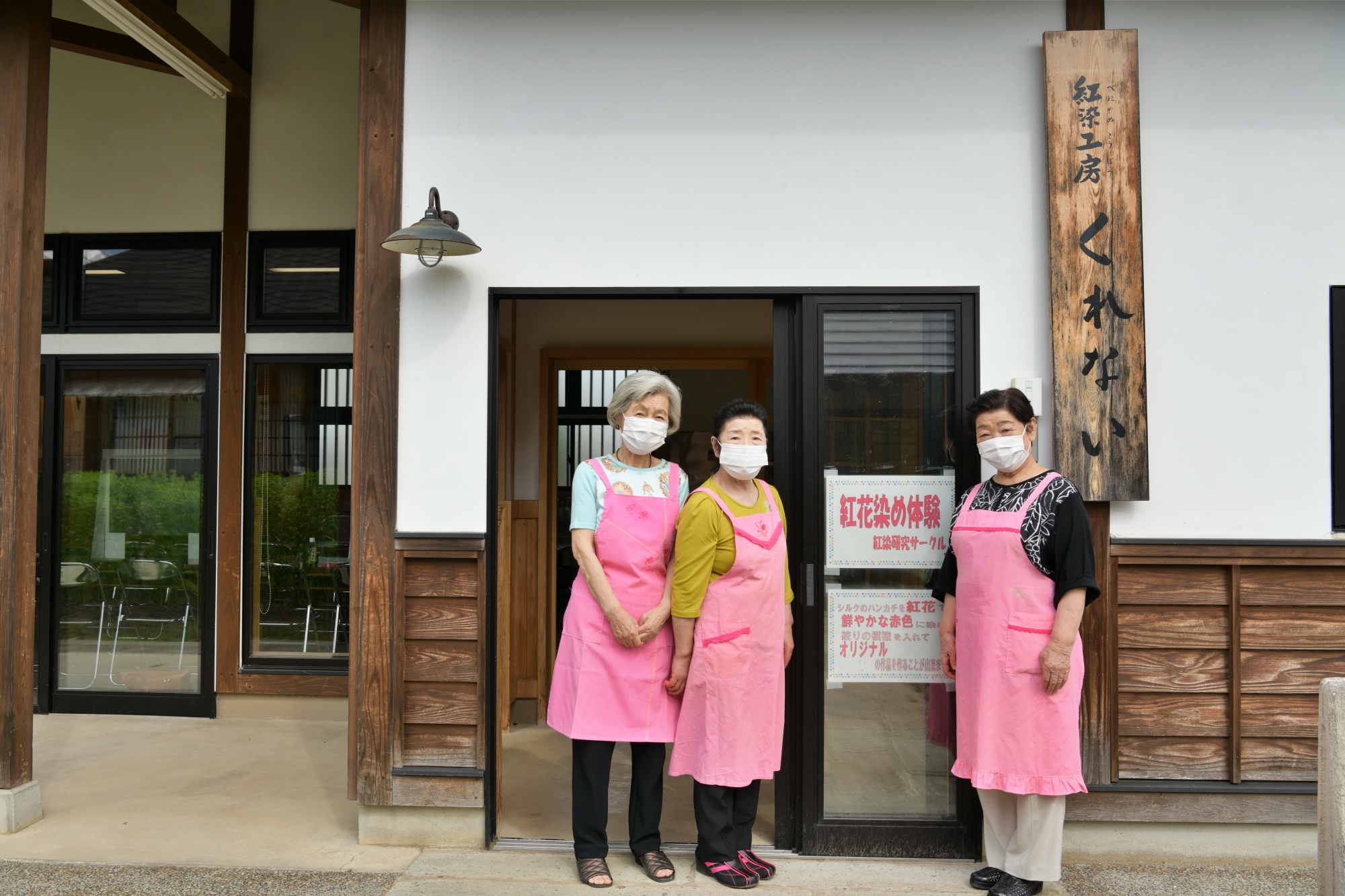
From the left, Kimiko Suzuki, Kiyoko Asakara, Miyoko Endo
Finally, I received a message from Mr. Endo, the representative.
“First of all, please try the safflower dyeing experience that you can feel free to do.
After experiencing safflower dyeing, you can see the depth and fun of safflower dyeing by experiencing the whole process of picking safflower and making rice cakes.
Plant dyeing such as onions that are familiar to us is also very beautiful, so it is recommended to try it at home. “
6. Access etc.
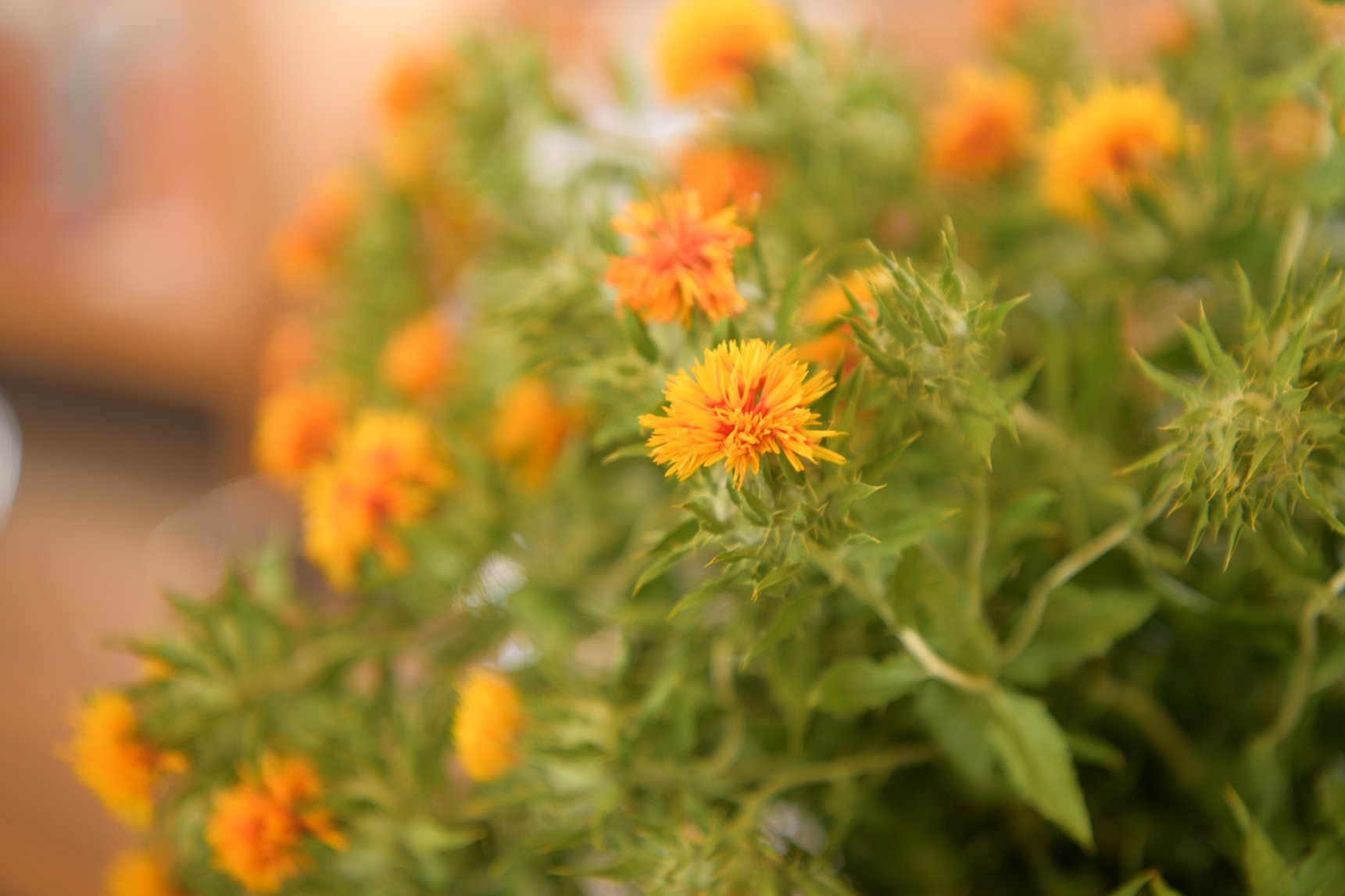
[access]
20 minutes by car from JR Yamagata Shinkansen bullet train “Cherry Higashine Station”
20 minutes by car from “Sagae Station” on the JR Aterazawa Line 15 minutes by car from Yamagata Airport 10 minutes by car from Yamagata Expressway Higashine IC
[Parking Lot]
Yes
[Hours]
March-October: 9: 00-17: 00
November-December: 9: 00-16: 00
[closing day]
2nd Thursday of every month (the next day if it is a holiday)
Year-end and New Year holidays December 29-January 3 of the following year
[Admission fee]
・ Individual admission Adult: 400 yen High school students: 150 yen Elementary and junior high school students: 70 yen
・ Customers admitted to groups (20 or more)
Adult: 350 yen High school students: 120 yen Elementary and junior high school students: 50 yen
* When presenting “Person with a physical disability certificate, Health and welfare certificate for the mentally disabled, Rehabilitation certificate”, it is as follows.
General: 300 yen, high school students: 100 yen, elementary and junior high school students: 50 yen
Detailed information

-
Benibana Museum
Yamagata Prefecture Yachi, Kahoku Town Kimi 885-1
0237-73-35000237-73-3500

![[Feature] Pino Collina Matsugaoka! Winery & Restaurant in Shonai](https://www.visityamagata.jp/wp/wp-content/uploads/2024/06/pinocollina.jpg)
![[Feature] Sahato Benihana! Enjoy the starry sky at the prefecture’s largest planetarium](https://www.visityamagata.jp/wp/wp-content/uploads/2024/07/sahato.jpg)
![[Feature] Miraini! Sakata Activity Hub](https://www.visityamagata.jp/wp/wp-content/uploads/2024/02/compile-image_1707742235039.png)
![[Feature] Yukotto! Refreshing time in hot springs](https://www.visityamagata.jp/wp/wp-content/uploads/2024/03/yukotto.jpg)